Integrated Business Challenge: Proposal for SAP Implementation
VerifiedAdded on 2023/06/15
|26
|8035
|475
AI Summary
This business case proposes the implementation of SAP ERP system for Colgate-Palmolive Limited to enhance their CSR activities and technical upgrades to increase market in Asian countries, especially India. The business case includes details of the project, estimated time and budget.
Contribute Materials
Your contribution can guide someone’s learning journey. Share your
documents today.
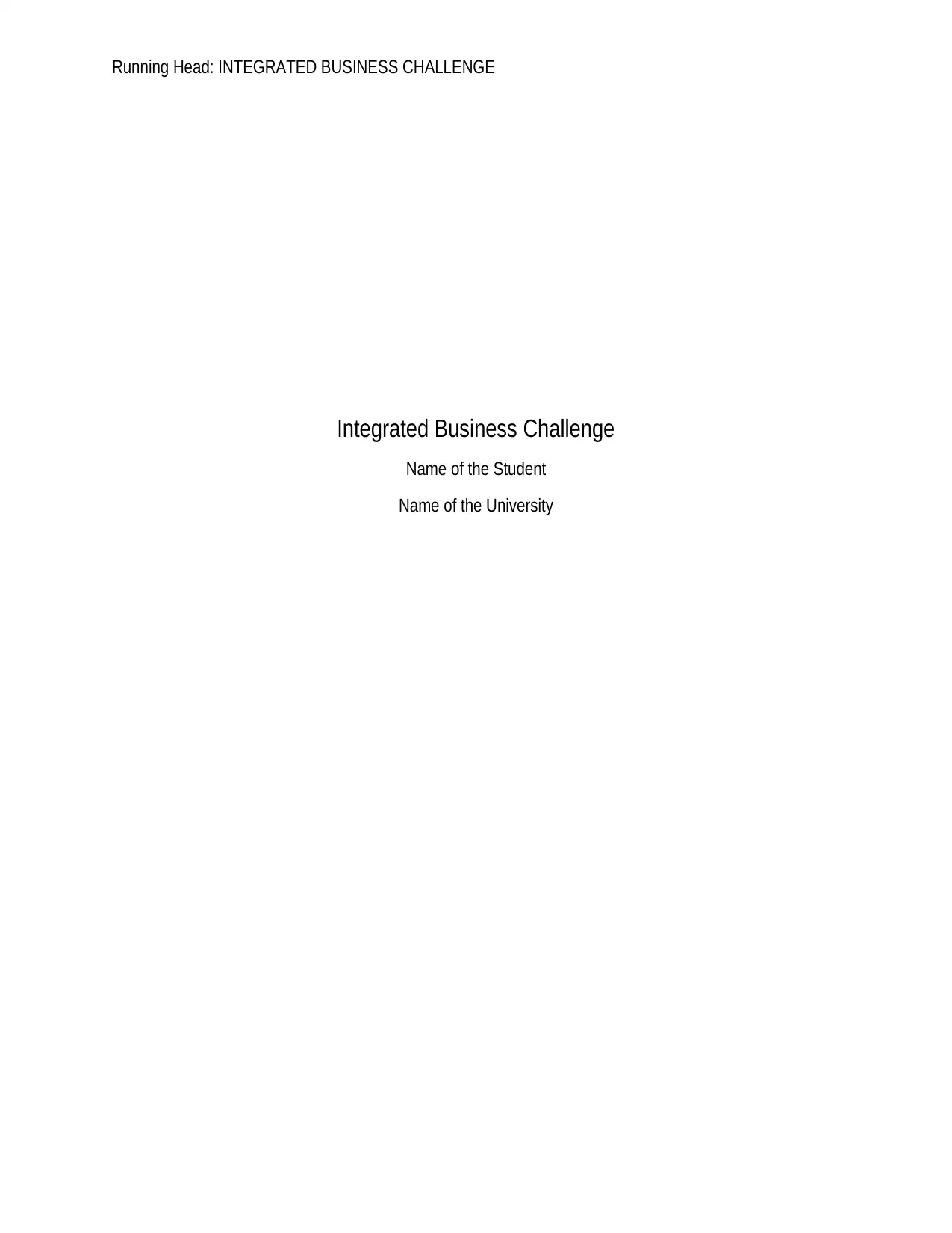
Running Head: INTEGRATED BUSINESS CHALLENGE
Integrated Business Challenge
Name of the Student
Name of the University
Integrated Business Challenge
Name of the Student
Name of the University
Secure Best Marks with AI Grader
Need help grading? Try our AI Grader for instant feedback on your assignments.
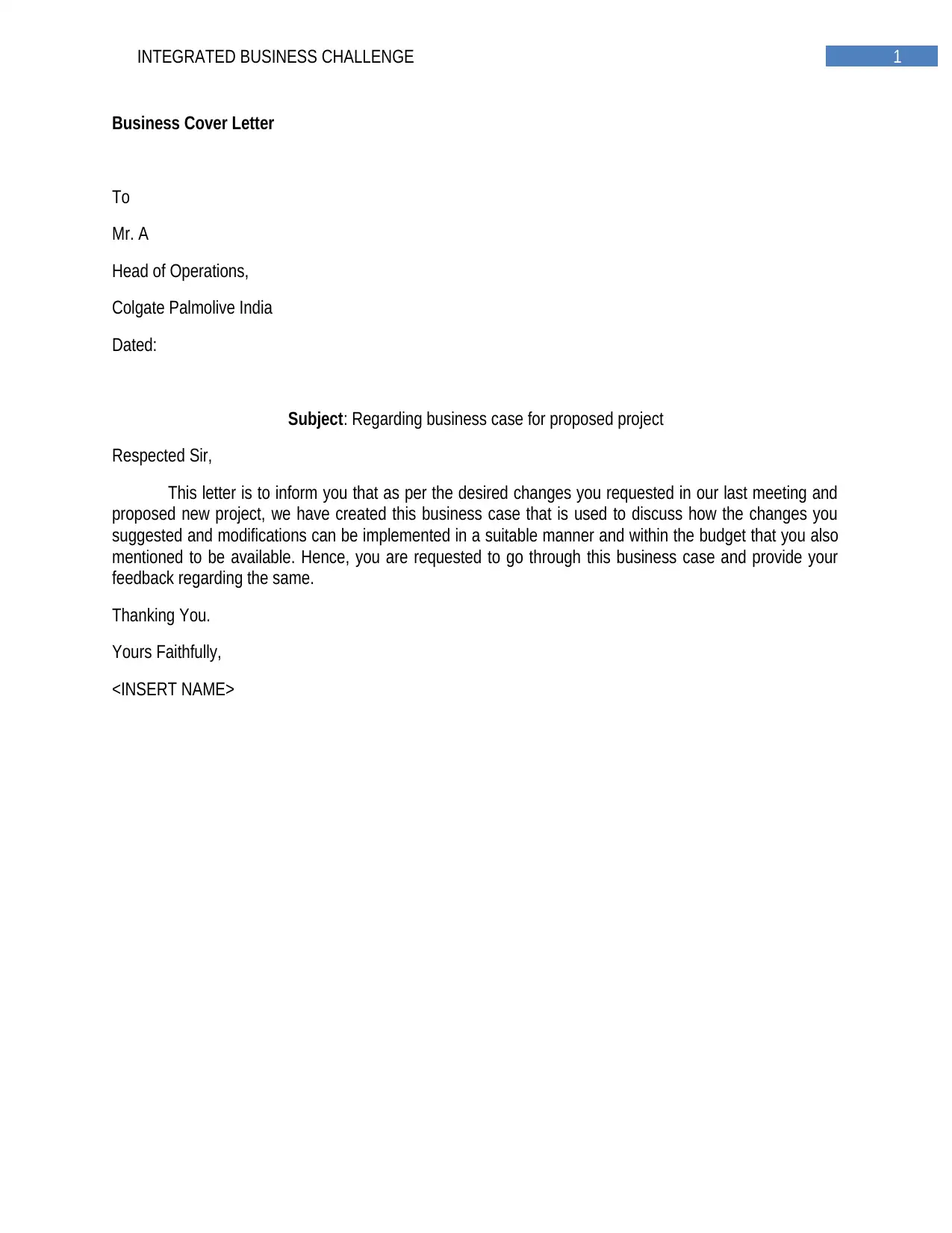
1INTEGRATED BUSINESS CHALLENGE
Business Cover Letter
To
Mr. A
Head of Operations,
Colgate Palmolive India
Dated:
Subject: Regarding business case for proposed project
Respected Sir,
This letter is to inform you that as per the desired changes you requested in our last meeting and
proposed new project, we have created this business case that is used to discuss how the changes you
suggested and modifications can be implemented in a suitable manner and within the budget that you also
mentioned to be available. Hence, you are requested to go through this business case and provide your
feedback regarding the same.
Thanking You.
Yours Faithfully,
<INSERT NAME>
Business Cover Letter
To
Mr. A
Head of Operations,
Colgate Palmolive India
Dated:
Subject: Regarding business case for proposed project
Respected Sir,
This letter is to inform you that as per the desired changes you requested in our last meeting and
proposed new project, we have created this business case that is used to discuss how the changes you
suggested and modifications can be implemented in a suitable manner and within the budget that you also
mentioned to be available. Hence, you are requested to go through this business case and provide your
feedback regarding the same.
Thanking You.
Yours Faithfully,
<INSERT NAME>

2INTEGRATED BUSINESS CHALLENGE
Executive Summary
This business case is prepared based on a proposed project plan for Colgate-Palmolive Limited. As per
their requirement, they want to develop their CSR activities in addition to technical upgrades to increase
market in Asian countries, especially India. For fulfilling their purpose, development of SAP system has
been suggested that will help them in significant technical upgrade as well as prepare a better and efficient
management system for the CSR projects and campaigns that they plan to conduct in India in the near
future. In other words, the implementation of the SAP system and integrate it with the existing system in the
company would be very beneficial for the company. The main aim is to increase the efficiency for the
company and reduce the complexities that are faced by the staffs within the company. In this business
case, the details of project as well as estimated time and budget have been provided.
Executive Summary
This business case is prepared based on a proposed project plan for Colgate-Palmolive Limited. As per
their requirement, they want to develop their CSR activities in addition to technical upgrades to increase
market in Asian countries, especially India. For fulfilling their purpose, development of SAP system has
been suggested that will help them in significant technical upgrade as well as prepare a better and efficient
management system for the CSR projects and campaigns that they plan to conduct in India in the near
future. In other words, the implementation of the SAP system and integrate it with the existing system in the
company would be very beneficial for the company. The main aim is to increase the efficiency for the
company and reduce the complexities that are faced by the staffs within the company. In this business
case, the details of project as well as estimated time and budget have been provided.
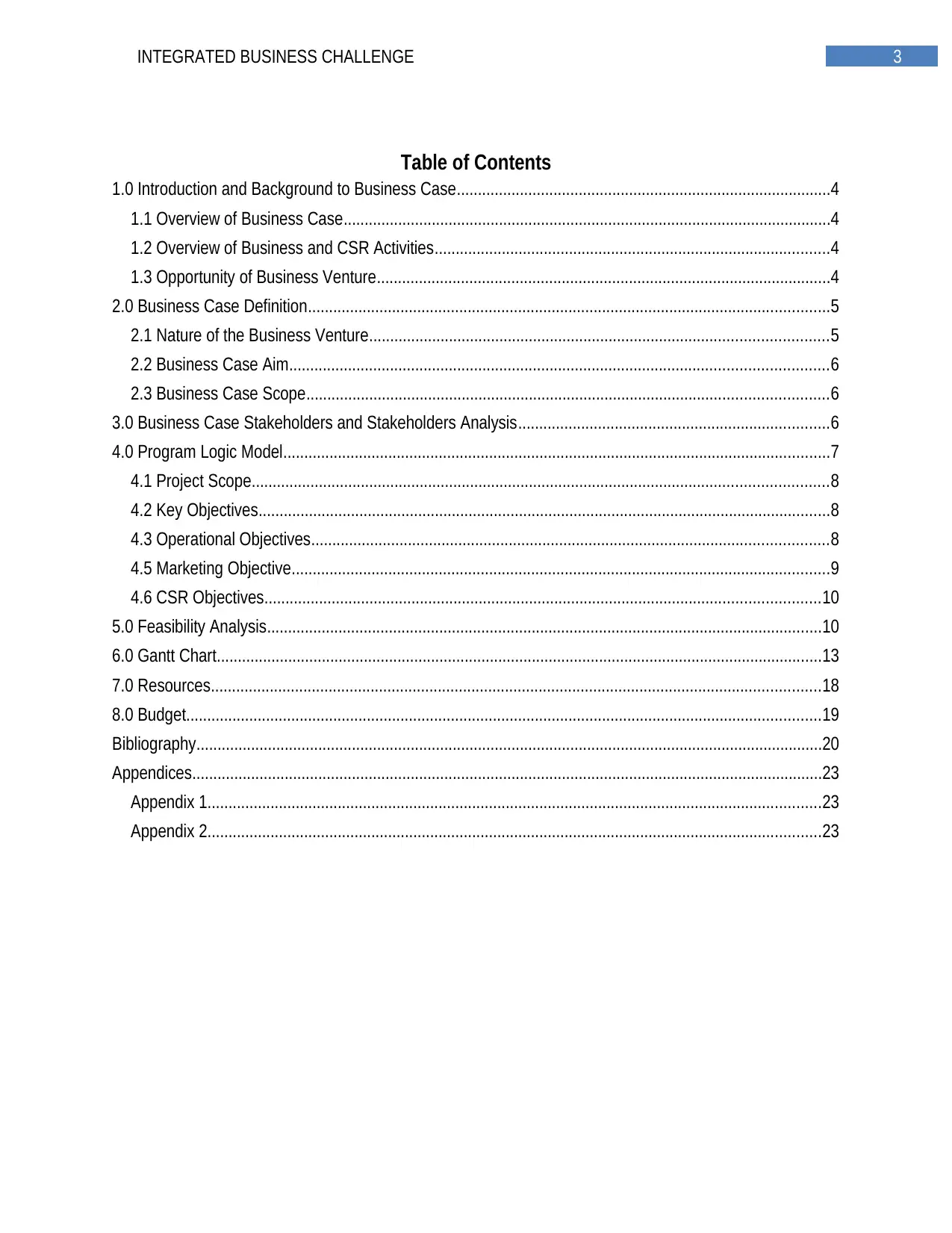
3INTEGRATED BUSINESS CHALLENGE
Table of Contents
1.0 Introduction and Background to Business Case.........................................................................................4
1.1 Overview of Business Case....................................................................................................................4
1.2 Overview of Business and CSR Activities..............................................................................................4
1.3 Opportunity of Business Venture............................................................................................................4
2.0 Business Case Definition............................................................................................................................5
2.1 Nature of the Business Venture.............................................................................................................5
2.2 Business Case Aim................................................................................................................................6
2.3 Business Case Scope............................................................................................................................6
3.0 Business Case Stakeholders and Stakeholders Analysis..........................................................................6
4.0 Program Logic Model..................................................................................................................................7
4.1 Project Scope.........................................................................................................................................8
4.2 Key Objectives........................................................................................................................................8
4.3 Operational Objectives...........................................................................................................................8
4.5 Marketing Objective................................................................................................................................9
4.6 CSR Objectives....................................................................................................................................10
5.0 Feasibility Analysis....................................................................................................................................10
6.0 Gantt Chart................................................................................................................................................13
7.0 Resources.................................................................................................................................................18
8.0 Budget.......................................................................................................................................................19
Bibliography.....................................................................................................................................................20
Appendices......................................................................................................................................................23
Appendix 1..................................................................................................................................................23
Appendix 2..................................................................................................................................................23
Table of Contents
1.0 Introduction and Background to Business Case.........................................................................................4
1.1 Overview of Business Case....................................................................................................................4
1.2 Overview of Business and CSR Activities..............................................................................................4
1.3 Opportunity of Business Venture............................................................................................................4
2.0 Business Case Definition............................................................................................................................5
2.1 Nature of the Business Venture.............................................................................................................5
2.2 Business Case Aim................................................................................................................................6
2.3 Business Case Scope............................................................................................................................6
3.0 Business Case Stakeholders and Stakeholders Analysis..........................................................................6
4.0 Program Logic Model..................................................................................................................................7
4.1 Project Scope.........................................................................................................................................8
4.2 Key Objectives........................................................................................................................................8
4.3 Operational Objectives...........................................................................................................................8
4.5 Marketing Objective................................................................................................................................9
4.6 CSR Objectives....................................................................................................................................10
5.0 Feasibility Analysis....................................................................................................................................10
6.0 Gantt Chart................................................................................................................................................13
7.0 Resources.................................................................................................................................................18
8.0 Budget.......................................................................................................................................................19
Bibliography.....................................................................................................................................................20
Appendices......................................................................................................................................................23
Appendix 1..................................................................................................................................................23
Appendix 2..................................................................................................................................................23
Secure Best Marks with AI Grader
Need help grading? Try our AI Grader for instant feedback on your assignments.
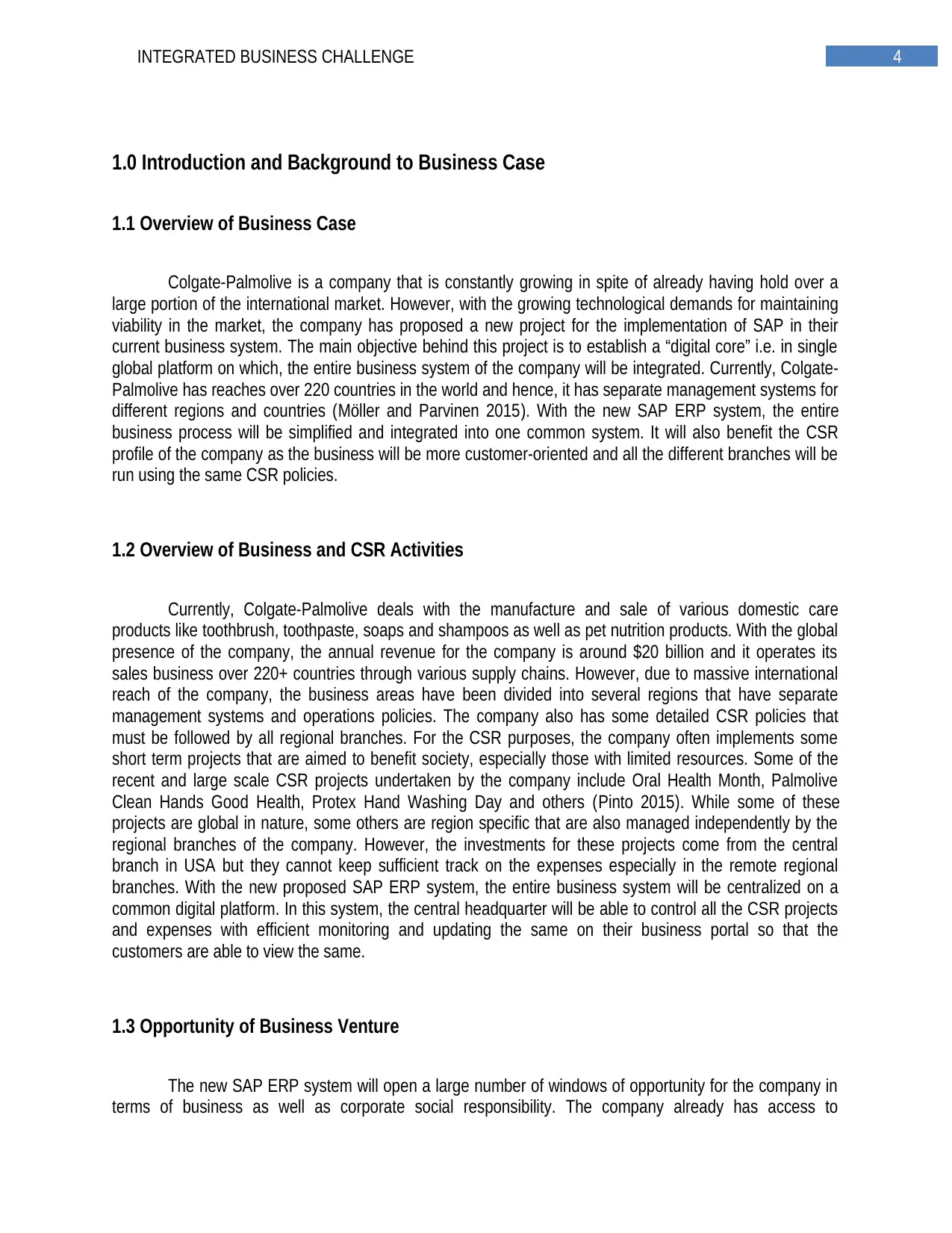
4INTEGRATED BUSINESS CHALLENGE
1.0 Introduction and Background to Business Case
1.1 Overview of Business Case
Colgate-Palmolive is a company that is constantly growing in spite of already having hold over a
large portion of the international market. However, with the growing technological demands for maintaining
viability in the market, the company has proposed a new project for the implementation of SAP in their
current business system. The main objective behind this project is to establish a “digital core” i.e. in single
global platform on which, the entire business system of the company will be integrated. Currently, Colgate-
Palmolive has reaches over 220 countries in the world and hence, it has separate management systems for
different regions and countries (Möller and Parvinen 2015). With the new SAP ERP system, the entire
business process will be simplified and integrated into one common system. It will also benefit the CSR
profile of the company as the business will be more customer-oriented and all the different branches will be
run using the same CSR policies.
1.2 Overview of Business and CSR Activities
Currently, Colgate-Palmolive deals with the manufacture and sale of various domestic care
products like toothbrush, toothpaste, soaps and shampoos as well as pet nutrition products. With the global
presence of the company, the annual revenue for the company is around $20 billion and it operates its
sales business over 220+ countries through various supply chains. However, due to massive international
reach of the company, the business areas have been divided into several regions that have separate
management systems and operations policies. The company also has some detailed CSR policies that
must be followed by all regional branches. For the CSR purposes, the company often implements some
short term projects that are aimed to benefit society, especially those with limited resources. Some of the
recent and large scale CSR projects undertaken by the company include Oral Health Month, Palmolive
Clean Hands Good Health, Protex Hand Washing Day and others (Pinto 2015). While some of these
projects are global in nature, some others are region specific that are also managed independently by the
regional branches of the company. However, the investments for these projects come from the central
branch in USA but they cannot keep sufficient track on the expenses especially in the remote regional
branches. With the new proposed SAP ERP system, the entire business system will be centralized on a
common digital platform. In this system, the central headquarter will be able to control all the CSR projects
and expenses with efficient monitoring and updating the same on their business portal so that the
customers are able to view the same.
1.3 Opportunity of Business Venture
The new SAP ERP system will open a large number of windows of opportunity for the company in
terms of business as well as corporate social responsibility. The company already has access to
1.0 Introduction and Background to Business Case
1.1 Overview of Business Case
Colgate-Palmolive is a company that is constantly growing in spite of already having hold over a
large portion of the international market. However, with the growing technological demands for maintaining
viability in the market, the company has proposed a new project for the implementation of SAP in their
current business system. The main objective behind this project is to establish a “digital core” i.e. in single
global platform on which, the entire business system of the company will be integrated. Currently, Colgate-
Palmolive has reaches over 220 countries in the world and hence, it has separate management systems for
different regions and countries (Möller and Parvinen 2015). With the new SAP ERP system, the entire
business process will be simplified and integrated into one common system. It will also benefit the CSR
profile of the company as the business will be more customer-oriented and all the different branches will be
run using the same CSR policies.
1.2 Overview of Business and CSR Activities
Currently, Colgate-Palmolive deals with the manufacture and sale of various domestic care
products like toothbrush, toothpaste, soaps and shampoos as well as pet nutrition products. With the global
presence of the company, the annual revenue for the company is around $20 billion and it operates its
sales business over 220+ countries through various supply chains. However, due to massive international
reach of the company, the business areas have been divided into several regions that have separate
management systems and operations policies. The company also has some detailed CSR policies that
must be followed by all regional branches. For the CSR purposes, the company often implements some
short term projects that are aimed to benefit society, especially those with limited resources. Some of the
recent and large scale CSR projects undertaken by the company include Oral Health Month, Palmolive
Clean Hands Good Health, Protex Hand Washing Day and others (Pinto 2015). While some of these
projects are global in nature, some others are region specific that are also managed independently by the
regional branches of the company. However, the investments for these projects come from the central
branch in USA but they cannot keep sufficient track on the expenses especially in the remote regional
branches. With the new proposed SAP ERP system, the entire business system will be centralized on a
common digital platform. In this system, the central headquarter will be able to control all the CSR projects
and expenses with efficient monitoring and updating the same on their business portal so that the
customers are able to view the same.
1.3 Opportunity of Business Venture
The new SAP ERP system will open a large number of windows of opportunity for the company in
terms of business as well as corporate social responsibility. The company already has access to
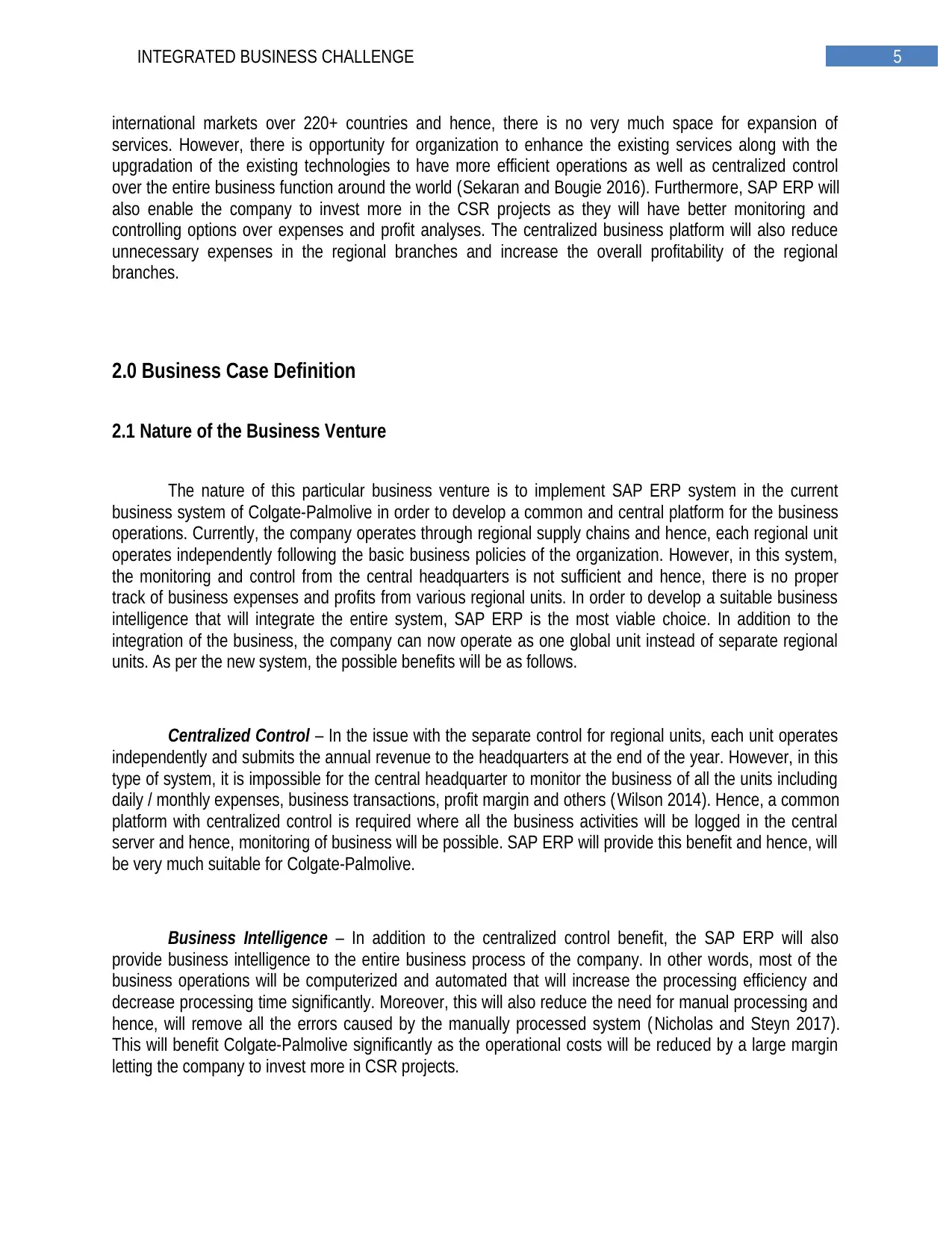
5INTEGRATED BUSINESS CHALLENGE
international markets over 220+ countries and hence, there is no very much space for expansion of
services. However, there is opportunity for organization to enhance the existing services along with the
upgradation of the existing technologies to have more efficient operations as well as centralized control
over the entire business function around the world (Sekaran and Bougie 2016). Furthermore, SAP ERP will
also enable the company to invest more in the CSR projects as they will have better monitoring and
controlling options over expenses and profit analyses. The centralized business platform will also reduce
unnecessary expenses in the regional branches and increase the overall profitability of the regional
branches.
2.0 Business Case Definition
2.1 Nature of the Business Venture
The nature of this particular business venture is to implement SAP ERP system in the current
business system of Colgate-Palmolive in order to develop a common and central platform for the business
operations. Currently, the company operates through regional supply chains and hence, each regional unit
operates independently following the basic business policies of the organization. However, in this system,
the monitoring and control from the central headquarters is not sufficient and hence, there is no proper
track of business expenses and profits from various regional units. In order to develop a suitable business
intelligence that will integrate the entire system, SAP ERP is the most viable choice. In addition to the
integration of the business, the company can now operate as one global unit instead of separate regional
units. As per the new system, the possible benefits will be as follows.
Centralized Control – In the issue with the separate control for regional units, each unit operates
independently and submits the annual revenue to the headquarters at the end of the year. However, in this
type of system, it is impossible for the central headquarter to monitor the business of all the units including
daily / monthly expenses, business transactions, profit margin and others (Wilson 2014). Hence, a common
platform with centralized control is required where all the business activities will be logged in the central
server and hence, monitoring of business will be possible. SAP ERP will provide this benefit and hence, will
be very much suitable for Colgate-Palmolive.
Business Intelligence – In addition to the centralized control benefit, the SAP ERP will also
provide business intelligence to the entire business process of the company. In other words, most of the
business operations will be computerized and automated that will increase the processing efficiency and
decrease processing time significantly. Moreover, this will also reduce the need for manual processing and
hence, will remove all the errors caused by the manually processed system ( Nicholas and Steyn 2017).
This will benefit Colgate-Palmolive significantly as the operational costs will be reduced by a large margin
letting the company to invest more in CSR projects.
international markets over 220+ countries and hence, there is no very much space for expansion of
services. However, there is opportunity for organization to enhance the existing services along with the
upgradation of the existing technologies to have more efficient operations as well as centralized control
over the entire business function around the world (Sekaran and Bougie 2016). Furthermore, SAP ERP will
also enable the company to invest more in the CSR projects as they will have better monitoring and
controlling options over expenses and profit analyses. The centralized business platform will also reduce
unnecessary expenses in the regional branches and increase the overall profitability of the regional
branches.
2.0 Business Case Definition
2.1 Nature of the Business Venture
The nature of this particular business venture is to implement SAP ERP system in the current
business system of Colgate-Palmolive in order to develop a common and central platform for the business
operations. Currently, the company operates through regional supply chains and hence, each regional unit
operates independently following the basic business policies of the organization. However, in this system,
the monitoring and control from the central headquarters is not sufficient and hence, there is no proper
track of business expenses and profits from various regional units. In order to develop a suitable business
intelligence that will integrate the entire system, SAP ERP is the most viable choice. In addition to the
integration of the business, the company can now operate as one global unit instead of separate regional
units. As per the new system, the possible benefits will be as follows.
Centralized Control – In the issue with the separate control for regional units, each unit operates
independently and submits the annual revenue to the headquarters at the end of the year. However, in this
type of system, it is impossible for the central headquarter to monitor the business of all the units including
daily / monthly expenses, business transactions, profit margin and others (Wilson 2014). Hence, a common
platform with centralized control is required where all the business activities will be logged in the central
server and hence, monitoring of business will be possible. SAP ERP will provide this benefit and hence, will
be very much suitable for Colgate-Palmolive.
Business Intelligence – In addition to the centralized control benefit, the SAP ERP will also
provide business intelligence to the entire business process of the company. In other words, most of the
business operations will be computerized and automated that will increase the processing efficiency and
decrease processing time significantly. Moreover, this will also reduce the need for manual processing and
hence, will remove all the errors caused by the manually processed system ( Nicholas and Steyn 2017).
This will benefit Colgate-Palmolive significantly as the operational costs will be reduced by a large margin
letting the company to invest more in CSR projects.
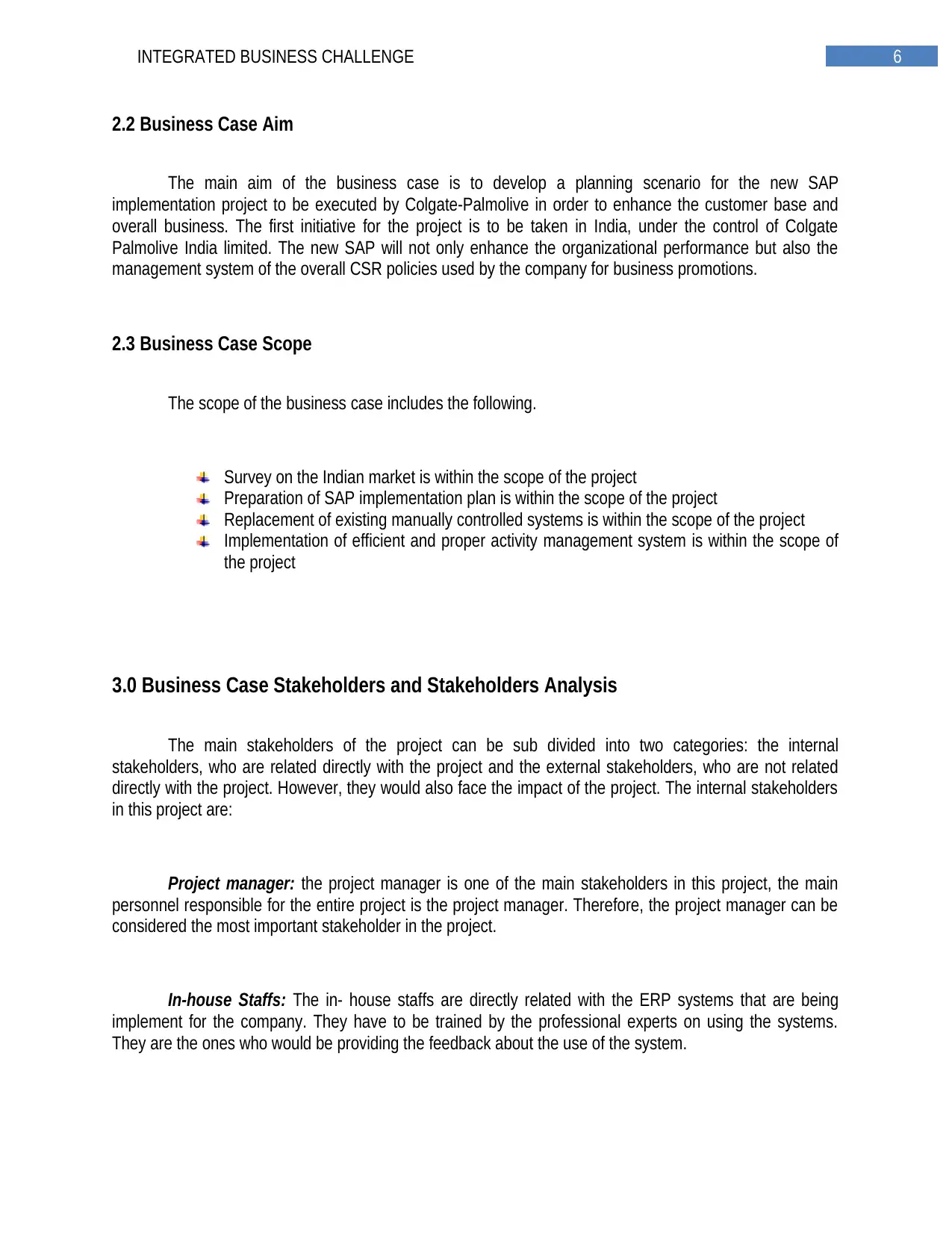
6INTEGRATED BUSINESS CHALLENGE
2.2 Business Case Aim
The main aim of the business case is to develop a planning scenario for the new SAP
implementation project to be executed by Colgate-Palmolive in order to enhance the customer base and
overall business. The first initiative for the project is to be taken in India, under the control of Colgate
Palmolive India limited. The new SAP will not only enhance the organizational performance but also the
management system of the overall CSR policies used by the company for business promotions.
2.3 Business Case Scope
The scope of the business case includes the following.
Survey on the Indian market is within the scope of the project
Preparation of SAP implementation plan is within the scope of the project
Replacement of existing manually controlled systems is within the scope of the project
Implementation of efficient and proper activity management system is within the scope of
the project
3.0 Business Case Stakeholders and Stakeholders Analysis
The main stakeholders of the project can be sub divided into two categories: the internal
stakeholders, who are related directly with the project and the external stakeholders, who are not related
directly with the project. However, they would also face the impact of the project. The internal stakeholders
in this project are:
Project manager: the project manager is one of the main stakeholders in this project, the main
personnel responsible for the entire project is the project manager. Therefore, the project manager can be
considered the most important stakeholder in the project.
In-house Staffs: The in- house staffs are directly related with the ERP systems that are being
implement for the company. They have to be trained by the professional experts on using the systems.
They are the ones who would be providing the feedback about the use of the system.
2.2 Business Case Aim
The main aim of the business case is to develop a planning scenario for the new SAP
implementation project to be executed by Colgate-Palmolive in order to enhance the customer base and
overall business. The first initiative for the project is to be taken in India, under the control of Colgate
Palmolive India limited. The new SAP will not only enhance the organizational performance but also the
management system of the overall CSR policies used by the company for business promotions.
2.3 Business Case Scope
The scope of the business case includes the following.
Survey on the Indian market is within the scope of the project
Preparation of SAP implementation plan is within the scope of the project
Replacement of existing manually controlled systems is within the scope of the project
Implementation of efficient and proper activity management system is within the scope of
the project
3.0 Business Case Stakeholders and Stakeholders Analysis
The main stakeholders of the project can be sub divided into two categories: the internal
stakeholders, who are related directly with the project and the external stakeholders, who are not related
directly with the project. However, they would also face the impact of the project. The internal stakeholders
in this project are:
Project manager: the project manager is one of the main stakeholders in this project, the main
personnel responsible for the entire project is the project manager. Therefore, the project manager can be
considered the most important stakeholder in the project.
In-house Staffs: The in- house staffs are directly related with the ERP systems that are being
implement for the company. They have to be trained by the professional experts on using the systems.
They are the ones who would be providing the feedback about the use of the system.
Paraphrase This Document
Need a fresh take? Get an instant paraphrase of this document with our AI Paraphraser
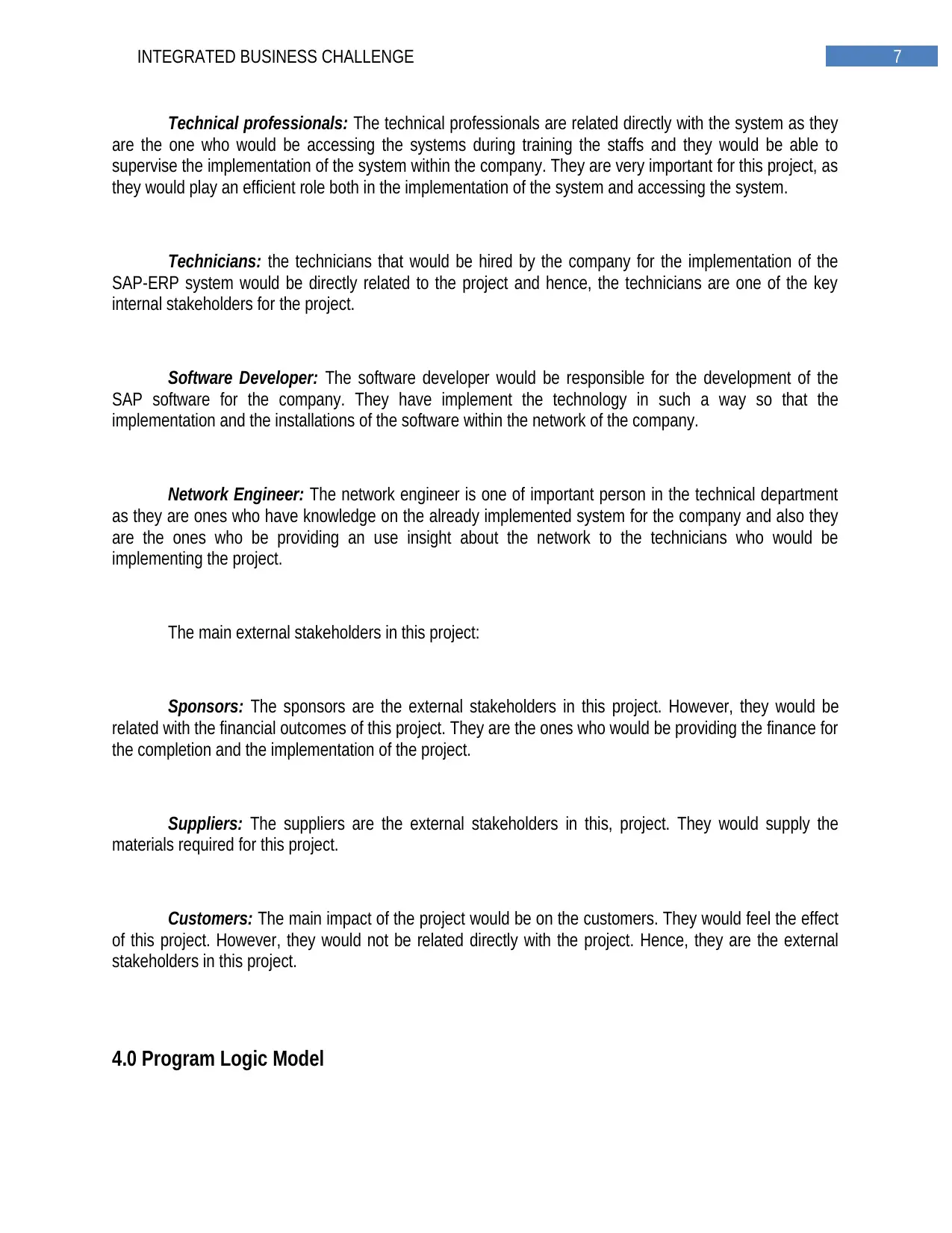
7INTEGRATED BUSINESS CHALLENGE
Technical professionals: The technical professionals are related directly with the system as they
are the one who would be accessing the systems during training the staffs and they would be able to
supervise the implementation of the system within the company. They are very important for this project, as
they would play an efficient role both in the implementation of the system and accessing the system.
Technicians: the technicians that would be hired by the company for the implementation of the
SAP-ERP system would be directly related to the project and hence, the technicians are one of the key
internal stakeholders for the project.
Software Developer: The software developer would be responsible for the development of the
SAP software for the company. They have implement the technology in such a way so that the
implementation and the installations of the software within the network of the company.
Network Engineer: The network engineer is one of important person in the technical department
as they are ones who have knowledge on the already implemented system for the company and also they
are the ones who be providing an use insight about the network to the technicians who would be
implementing the project.
The main external stakeholders in this project:
Sponsors: The sponsors are the external stakeholders in this project. However, they would be
related with the financial outcomes of this project. They are the ones who would be providing the finance for
the completion and the implementation of the project.
Suppliers: The suppliers are the external stakeholders in this, project. They would supply the
materials required for this project.
Customers: The main impact of the project would be on the customers. They would feel the effect
of this project. However, they would not be related directly with the project. Hence, they are the external
stakeholders in this project.
4.0 Program Logic Model
Technical professionals: The technical professionals are related directly with the system as they
are the one who would be accessing the systems during training the staffs and they would be able to
supervise the implementation of the system within the company. They are very important for this project, as
they would play an efficient role both in the implementation of the system and accessing the system.
Technicians: the technicians that would be hired by the company for the implementation of the
SAP-ERP system would be directly related to the project and hence, the technicians are one of the key
internal stakeholders for the project.
Software Developer: The software developer would be responsible for the development of the
SAP software for the company. They have implement the technology in such a way so that the
implementation and the installations of the software within the network of the company.
Network Engineer: The network engineer is one of important person in the technical department
as they are ones who have knowledge on the already implemented system for the company and also they
are the ones who be providing an use insight about the network to the technicians who would be
implementing the project.
The main external stakeholders in this project:
Sponsors: The sponsors are the external stakeholders in this project. However, they would be
related with the financial outcomes of this project. They are the ones who would be providing the finance for
the completion and the implementation of the project.
Suppliers: The suppliers are the external stakeholders in this, project. They would supply the
materials required for this project.
Customers: The main impact of the project would be on the customers. They would feel the effect
of this project. However, they would not be related directly with the project. Hence, they are the external
stakeholders in this project.
4.0 Program Logic Model
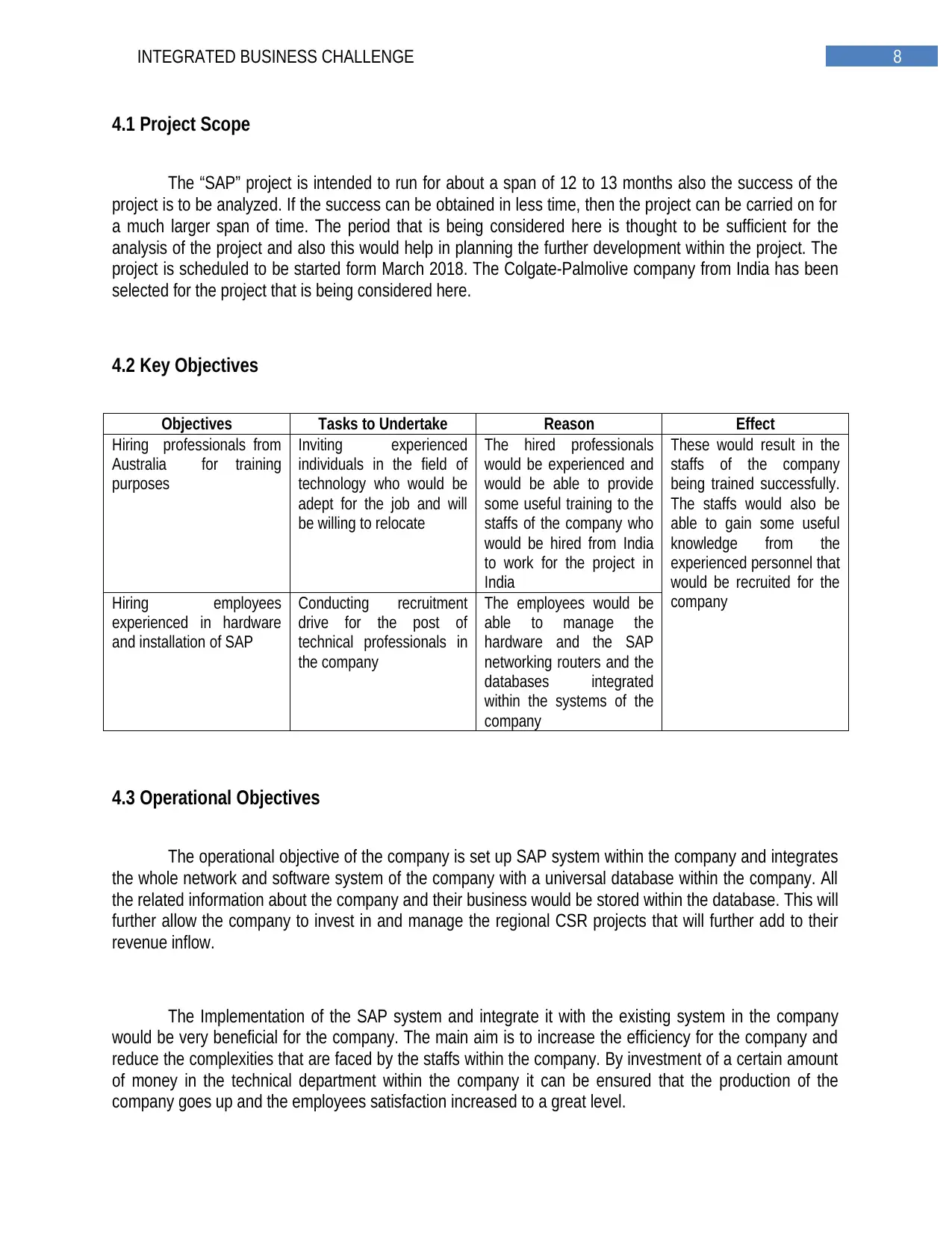
8INTEGRATED BUSINESS CHALLENGE
4.1 Project Scope
The “SAP” project is intended to run for about a span of 12 to 13 months also the success of the
project is to be analyzed. If the success can be obtained in less time, then the project can be carried on for
a much larger span of time. The period that is being considered here is thought to be sufficient for the
analysis of the project and also this would help in planning the further development within the project. The
project is scheduled to be started form March 2018. The Colgate-Palmolive company from India has been
selected for the project that is being considered here.
4.2 Key Objectives
Objectives Tasks to Undertake Reason Effect
Hiring professionals from
Australia for training
purposes
Inviting experienced
individuals in the field of
technology who would be
adept for the job and will
be willing to relocate
The hired professionals
would be experienced and
would be able to provide
some useful training to the
staffs of the company who
would be hired from India
to work for the project in
India
These would result in the
staffs of the company
being trained successfully.
The staffs would also be
able to gain some useful
knowledge from the
experienced personnel that
would be recruited for the
companyHiring employees
experienced in hardware
and installation of SAP
Conducting recruitment
drive for the post of
technical professionals in
the company
The employees would be
able to manage the
hardware and the SAP
networking routers and the
databases integrated
within the systems of the
company
4.3 Operational Objectives
The operational objective of the company is set up SAP system within the company and integrates
the whole network and software system of the company with a universal database within the company. All
the related information about the company and their business would be stored within the database. This will
further allow the company to invest in and manage the regional CSR projects that will further add to their
revenue inflow.
The Implementation of the SAP system and integrate it with the existing system in the company
would be very beneficial for the company. The main aim is to increase the efficiency for the company and
reduce the complexities that are faced by the staffs within the company. By investment of a certain amount
of money in the technical department within the company it can be ensured that the production of the
company goes up and the employees satisfaction increased to a great level.
4.1 Project Scope
The “SAP” project is intended to run for about a span of 12 to 13 months also the success of the
project is to be analyzed. If the success can be obtained in less time, then the project can be carried on for
a much larger span of time. The period that is being considered here is thought to be sufficient for the
analysis of the project and also this would help in planning the further development within the project. The
project is scheduled to be started form March 2018. The Colgate-Palmolive company from India has been
selected for the project that is being considered here.
4.2 Key Objectives
Objectives Tasks to Undertake Reason Effect
Hiring professionals from
Australia for training
purposes
Inviting experienced
individuals in the field of
technology who would be
adept for the job and will
be willing to relocate
The hired professionals
would be experienced and
would be able to provide
some useful training to the
staffs of the company who
would be hired from India
to work for the project in
India
These would result in the
staffs of the company
being trained successfully.
The staffs would also be
able to gain some useful
knowledge from the
experienced personnel that
would be recruited for the
companyHiring employees
experienced in hardware
and installation of SAP
Conducting recruitment
drive for the post of
technical professionals in
the company
The employees would be
able to manage the
hardware and the SAP
networking routers and the
databases integrated
within the systems of the
company
4.3 Operational Objectives
The operational objective of the company is set up SAP system within the company and integrates
the whole network and software system of the company with a universal database within the company. All
the related information about the company and their business would be stored within the database. This will
further allow the company to invest in and manage the regional CSR projects that will further add to their
revenue inflow.
The Implementation of the SAP system and integrate it with the existing system in the company
would be very beneficial for the company. The main aim is to increase the efficiency for the company and
reduce the complexities that are faced by the staffs within the company. By investment of a certain amount
of money in the technical department within the company it can be ensured that the production of the
company goes up and the employees satisfaction increased to a great level.
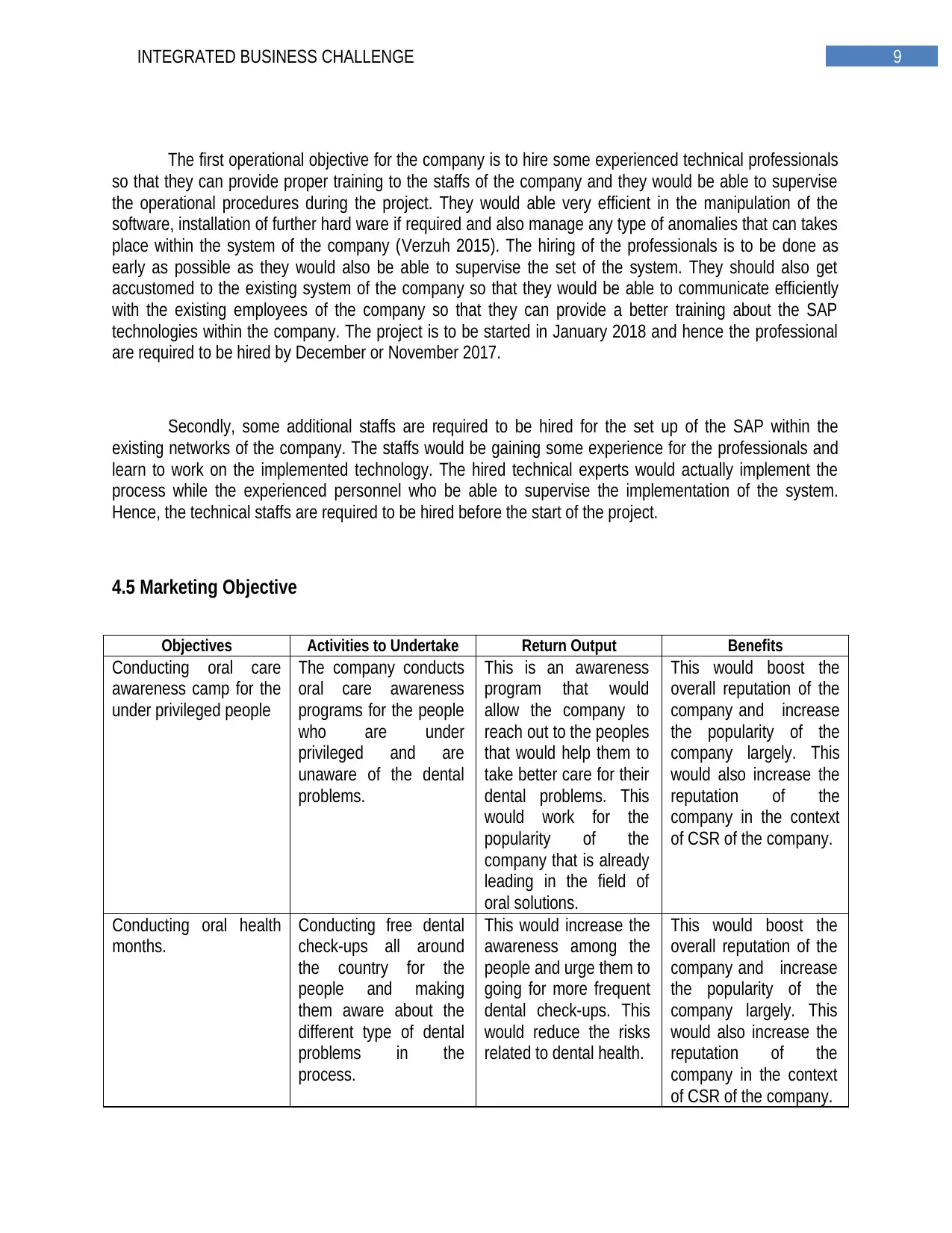
9INTEGRATED BUSINESS CHALLENGE
The first operational objective for the company is to hire some experienced technical professionals
so that they can provide proper training to the staffs of the company and they would be able to supervise
the operational procedures during the project. They would able very efficient in the manipulation of the
software, installation of further hard ware if required and also manage any type of anomalies that can takes
place within the system of the company (Verzuh 2015). The hiring of the professionals is to be done as
early as possible as they would also be able to supervise the set of the system. They should also get
accustomed to the existing system of the company so that they would be able to communicate efficiently
with the existing employees of the company so that they can provide a better training about the SAP
technologies within the company. The project is to be started in January 2018 and hence the professional
are required to be hired by December or November 2017.
Secondly, some additional staffs are required to be hired for the set up of the SAP within the
existing networks of the company. The staffs would be gaining some experience for the professionals and
learn to work on the implemented technology. The hired technical experts would actually implement the
process while the experienced personnel who be able to supervise the implementation of the system.
Hence, the technical staffs are required to be hired before the start of the project.
4.5 Marketing Objective
Objectives Activities to Undertake Return Output Benefits
Conducting oral care
awareness camp for the
under privileged people
The company conducts
oral care awareness
programs for the people
who are under
privileged and are
unaware of the dental
problems.
This is an awareness
program that would
allow the company to
reach out to the peoples
that would help them to
take better care for their
dental problems. This
would work for the
popularity of the
company that is already
leading in the field of
oral solutions.
This would boost the
overall reputation of the
company and increase
the popularity of the
company largely. This
would also increase the
reputation of the
company in the context
of CSR of the company.
Conducting oral health
months.
Conducting free dental
check-ups all around
the country for the
people and making
them aware about the
different type of dental
problems in the
process.
This would increase the
awareness among the
people and urge them to
going for more frequent
dental check-ups. This
would reduce the risks
related to dental health.
This would boost the
overall reputation of the
company and increase
the popularity of the
company largely. This
would also increase the
reputation of the
company in the context
of CSR of the company.
The first operational objective for the company is to hire some experienced technical professionals
so that they can provide proper training to the staffs of the company and they would be able to supervise
the operational procedures during the project. They would able very efficient in the manipulation of the
software, installation of further hard ware if required and also manage any type of anomalies that can takes
place within the system of the company (Verzuh 2015). The hiring of the professionals is to be done as
early as possible as they would also be able to supervise the set of the system. They should also get
accustomed to the existing system of the company so that they would be able to communicate efficiently
with the existing employees of the company so that they can provide a better training about the SAP
technologies within the company. The project is to be started in January 2018 and hence the professional
are required to be hired by December or November 2017.
Secondly, some additional staffs are required to be hired for the set up of the SAP within the
existing networks of the company. The staffs would be gaining some experience for the professionals and
learn to work on the implemented technology. The hired technical experts would actually implement the
process while the experienced personnel who be able to supervise the implementation of the system.
Hence, the technical staffs are required to be hired before the start of the project.
4.5 Marketing Objective
Objectives Activities to Undertake Return Output Benefits
Conducting oral care
awareness camp for the
under privileged people
The company conducts
oral care awareness
programs for the people
who are under
privileged and are
unaware of the dental
problems.
This is an awareness
program that would
allow the company to
reach out to the peoples
that would help them to
take better care for their
dental problems. This
would work for the
popularity of the
company that is already
leading in the field of
oral solutions.
This would boost the
overall reputation of the
company and increase
the popularity of the
company largely. This
would also increase the
reputation of the
company in the context
of CSR of the company.
Conducting oral health
months.
Conducting free dental
check-ups all around
the country for the
people and making
them aware about the
different type of dental
problems in the
process.
This would increase the
awareness among the
people and urge them to
going for more frequent
dental check-ups. This
would reduce the risks
related to dental health.
This would boost the
overall reputation of the
company and increase
the popularity of the
company largely. This
would also increase the
reputation of the
company in the context
of CSR of the company.
Secure Best Marks with AI Grader
Need help grading? Try our AI Grader for instant feedback on your assignments.
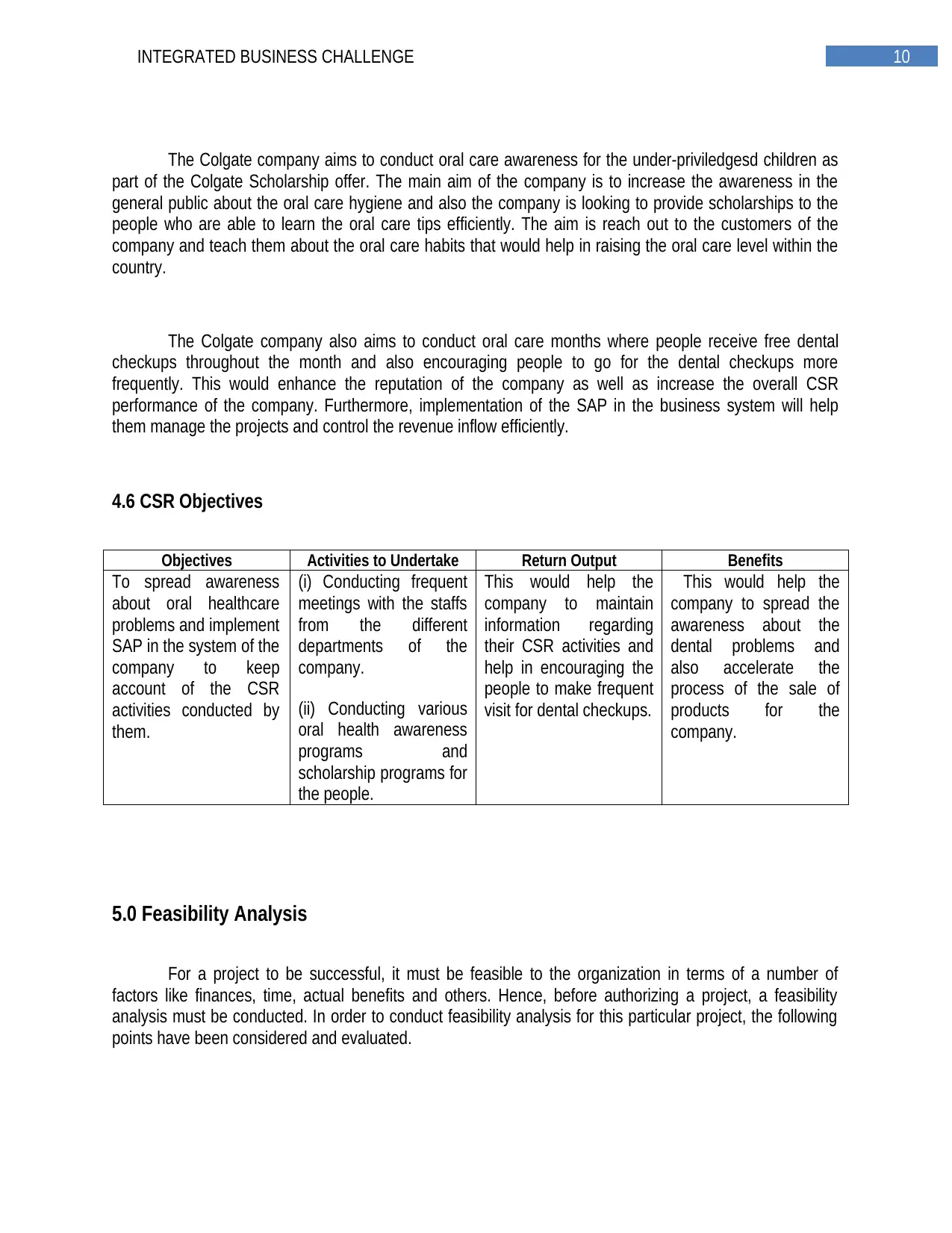
10INTEGRATED BUSINESS CHALLENGE
The Colgate company aims to conduct oral care awareness for the under-priviledgesd children as
part of the Colgate Scholarship offer. The main aim of the company is to increase the awareness in the
general public about the oral care hygiene and also the company is looking to provide scholarships to the
people who are able to learn the oral care tips efficiently. The aim is reach out to the customers of the
company and teach them about the oral care habits that would help in raising the oral care level within the
country.
The Colgate company also aims to conduct oral care months where people receive free dental
checkups throughout the month and also encouraging people to go for the dental checkups more
frequently. This would enhance the reputation of the company as well as increase the overall CSR
performance of the company. Furthermore, implementation of the SAP in the business system will help
them manage the projects and control the revenue inflow efficiently.
4.6 CSR Objectives
Objectives Activities to Undertake Return Output Benefits
To spread awareness
about oral healthcare
problems and implement
SAP in the system of the
company to keep
account of the CSR
activities conducted by
them.
(i) Conducting frequent
meetings with the staffs
from the different
departments of the
company.
(ii) Conducting various
oral health awareness
programs and
scholarship programs for
the people.
This would help the
company to maintain
information regarding
their CSR activities and
help in encouraging the
people to make frequent
visit for dental checkups.
This would help the
company to spread the
awareness about the
dental problems and
also accelerate the
process of the sale of
products for the
company.
5.0 Feasibility Analysis
For a project to be successful, it must be feasible to the organization in terms of a number of
factors like finances, time, actual benefits and others. Hence, before authorizing a project, a feasibility
analysis must be conducted. In order to conduct feasibility analysis for this particular project, the following
points have been considered and evaluated.
The Colgate company aims to conduct oral care awareness for the under-priviledgesd children as
part of the Colgate Scholarship offer. The main aim of the company is to increase the awareness in the
general public about the oral care hygiene and also the company is looking to provide scholarships to the
people who are able to learn the oral care tips efficiently. The aim is reach out to the customers of the
company and teach them about the oral care habits that would help in raising the oral care level within the
country.
The Colgate company also aims to conduct oral care months where people receive free dental
checkups throughout the month and also encouraging people to go for the dental checkups more
frequently. This would enhance the reputation of the company as well as increase the overall CSR
performance of the company. Furthermore, implementation of the SAP in the business system will help
them manage the projects and control the revenue inflow efficiently.
4.6 CSR Objectives
Objectives Activities to Undertake Return Output Benefits
To spread awareness
about oral healthcare
problems and implement
SAP in the system of the
company to keep
account of the CSR
activities conducted by
them.
(i) Conducting frequent
meetings with the staffs
from the different
departments of the
company.
(ii) Conducting various
oral health awareness
programs and
scholarship programs for
the people.
This would help the
company to maintain
information regarding
their CSR activities and
help in encouraging the
people to make frequent
visit for dental checkups.
This would help the
company to spread the
awareness about the
dental problems and
also accelerate the
process of the sale of
products for the
company.
5.0 Feasibility Analysis
For a project to be successful, it must be feasible to the organization in terms of a number of
factors like finances, time, actual benefits and others. Hence, before authorizing a project, a feasibility
analysis must be conducted. In order to conduct feasibility analysis for this particular project, the following
points have been considered and evaluated.
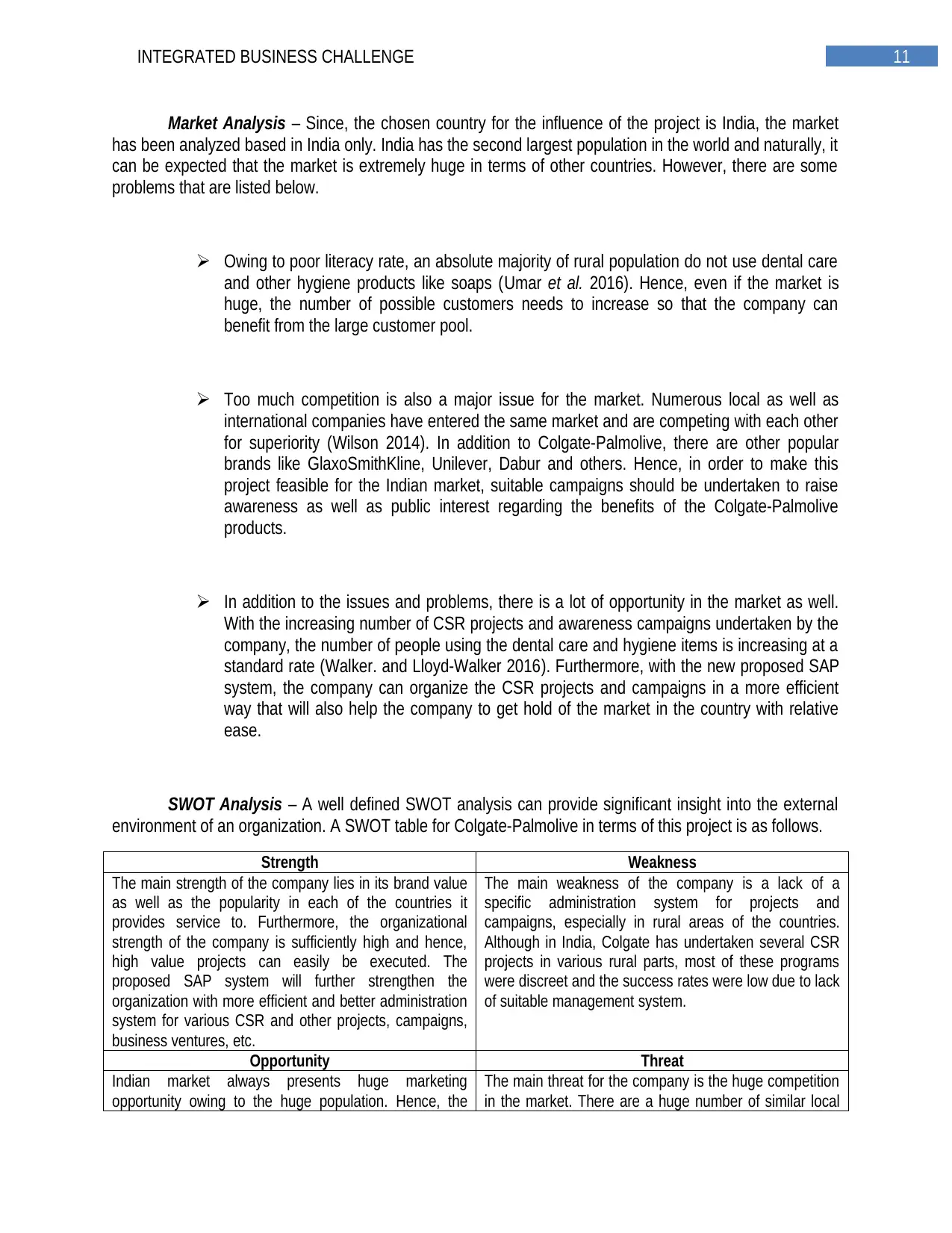
11INTEGRATED BUSINESS CHALLENGE
Market Analysis – Since, the chosen country for the influence of the project is India, the market
has been analyzed based in India only. India has the second largest population in the world and naturally, it
can be expected that the market is extremely huge in terms of other countries. However, there are some
problems that are listed below.
Owing to poor literacy rate, an absolute majority of rural population do not use dental care
and other hygiene products like soaps (Umar et al. 2016). Hence, even if the market is
huge, the number of possible customers needs to increase so that the company can
benefit from the large customer pool.
Too much competition is also a major issue for the market. Numerous local as well as
international companies have entered the same market and are competing with each other
for superiority (Wilson 2014). In addition to Colgate-Palmolive, there are other popular
brands like GlaxoSmithKline, Unilever, Dabur and others. Hence, in order to make this
project feasible for the Indian market, suitable campaigns should be undertaken to raise
awareness as well as public interest regarding the benefits of the Colgate-Palmolive
products.
In addition to the issues and problems, there is a lot of opportunity in the market as well.
With the increasing number of CSR projects and awareness campaigns undertaken by the
company, the number of people using the dental care and hygiene items is increasing at a
standard rate (Walker. and Lloyd-Walker 2016). Furthermore, with the new proposed SAP
system, the company can organize the CSR projects and campaigns in a more efficient
way that will also help the company to get hold of the market in the country with relative
ease.
SWOT Analysis – A well defined SWOT analysis can provide significant insight into the external
environment of an organization. A SWOT table for Colgate-Palmolive in terms of this project is as follows.
Strength Weakness
The main strength of the company lies in its brand value
as well as the popularity in each of the countries it
provides service to. Furthermore, the organizational
strength of the company is sufficiently high and hence,
high value projects can easily be executed. The
proposed SAP system will further strengthen the
organization with more efficient and better administration
system for various CSR and other projects, campaigns,
business ventures, etc.
The main weakness of the company is a lack of a
specific administration system for projects and
campaigns, especially in rural areas of the countries.
Although in India, Colgate has undertaken several CSR
projects in various rural parts, most of these programs
were discreet and the success rates were low due to lack
of suitable management system.
Opportunity Threat
Indian market always presents huge marketing
opportunity owing to the huge population. Hence, the
The main threat for the company is the huge competition
in the market. There are a huge number of similar local
Market Analysis – Since, the chosen country for the influence of the project is India, the market
has been analyzed based in India only. India has the second largest population in the world and naturally, it
can be expected that the market is extremely huge in terms of other countries. However, there are some
problems that are listed below.
Owing to poor literacy rate, an absolute majority of rural population do not use dental care
and other hygiene products like soaps (Umar et al. 2016). Hence, even if the market is
huge, the number of possible customers needs to increase so that the company can
benefit from the large customer pool.
Too much competition is also a major issue for the market. Numerous local as well as
international companies have entered the same market and are competing with each other
for superiority (Wilson 2014). In addition to Colgate-Palmolive, there are other popular
brands like GlaxoSmithKline, Unilever, Dabur and others. Hence, in order to make this
project feasible for the Indian market, suitable campaigns should be undertaken to raise
awareness as well as public interest regarding the benefits of the Colgate-Palmolive
products.
In addition to the issues and problems, there is a lot of opportunity in the market as well.
With the increasing number of CSR projects and awareness campaigns undertaken by the
company, the number of people using the dental care and hygiene items is increasing at a
standard rate (Walker. and Lloyd-Walker 2016). Furthermore, with the new proposed SAP
system, the company can organize the CSR projects and campaigns in a more efficient
way that will also help the company to get hold of the market in the country with relative
ease.
SWOT Analysis – A well defined SWOT analysis can provide significant insight into the external
environment of an organization. A SWOT table for Colgate-Palmolive in terms of this project is as follows.
Strength Weakness
The main strength of the company lies in its brand value
as well as the popularity in each of the countries it
provides service to. Furthermore, the organizational
strength of the company is sufficiently high and hence,
high value projects can easily be executed. The
proposed SAP system will further strengthen the
organization with more efficient and better administration
system for various CSR and other projects, campaigns,
business ventures, etc.
The main weakness of the company is a lack of a
specific administration system for projects and
campaigns, especially in rural areas of the countries.
Although in India, Colgate has undertaken several CSR
projects in various rural parts, most of these programs
were discreet and the success rates were low due to lack
of suitable management system.
Opportunity Threat
Indian market always presents huge marketing
opportunity owing to the huge population. Hence, the
The main threat for the company is the huge competition
in the market. There are a huge number of similar local
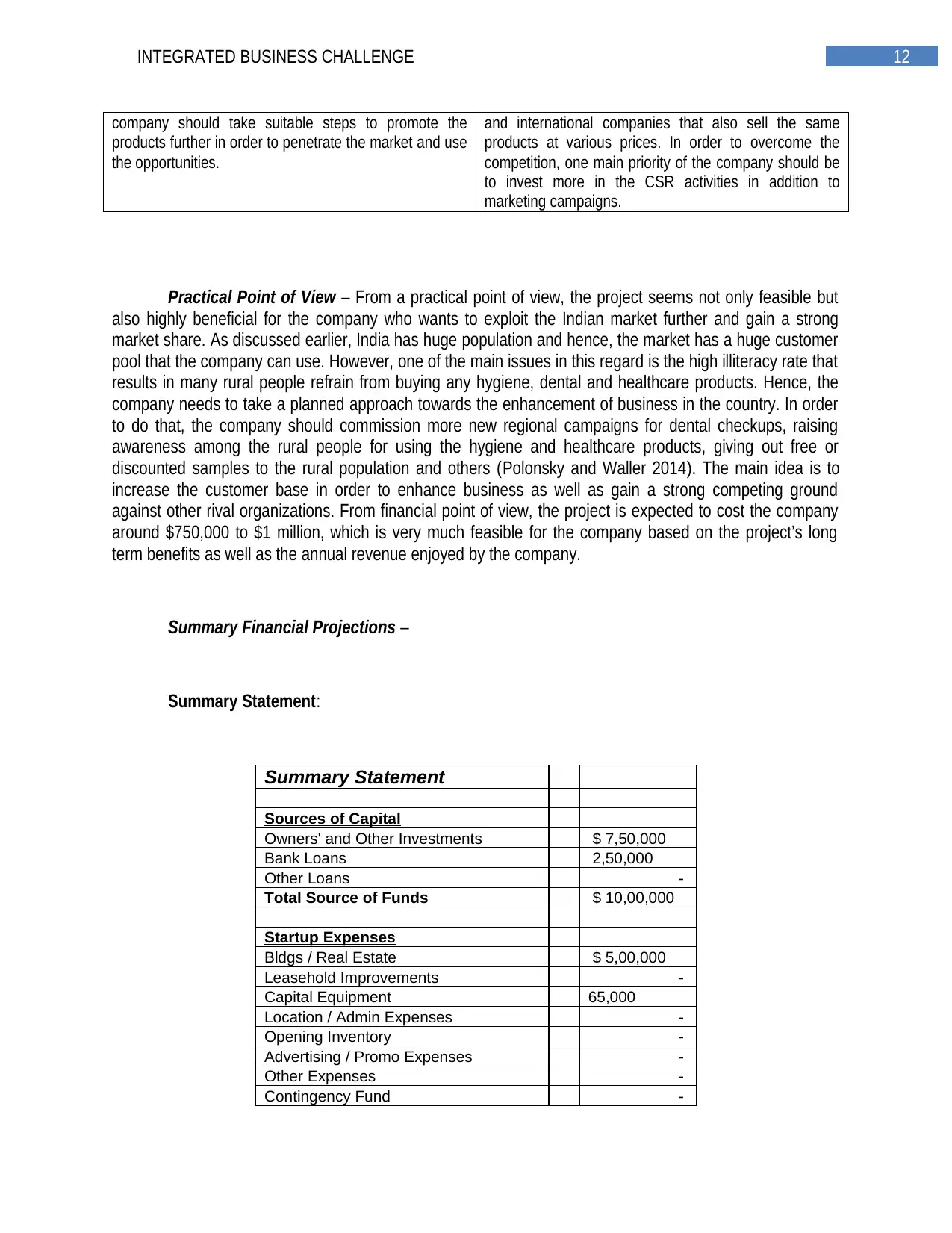
12INTEGRATED BUSINESS CHALLENGE
company should take suitable steps to promote the
products further in order to penetrate the market and use
the opportunities.
and international companies that also sell the same
products at various prices. In order to overcome the
competition, one main priority of the company should be
to invest more in the CSR activities in addition to
marketing campaigns.
Practical Point of View – From a practical point of view, the project seems not only feasible but
also highly beneficial for the company who wants to exploit the Indian market further and gain a strong
market share. As discussed earlier, India has huge population and hence, the market has a huge customer
pool that the company can use. However, one of the main issues in this regard is the high illiteracy rate that
results in many rural people refrain from buying any hygiene, dental and healthcare products. Hence, the
company needs to take a planned approach towards the enhancement of business in the country. In order
to do that, the company should commission more new regional campaigns for dental checkups, raising
awareness among the rural people for using the hygiene and healthcare products, giving out free or
discounted samples to the rural population and others (Polonsky and Waller 2014). The main idea is to
increase the customer base in order to enhance business as well as gain a strong competing ground
against other rival organizations. From financial point of view, the project is expected to cost the company
around $750,000 to $1 million, which is very much feasible for the company based on the project’s long
term benefits as well as the annual revenue enjoyed by the company.
Summary Financial Projections –
Summary Statement:
Summary Statement
Sources of Capital
Owners' and Other Investments $ 7,50,000
Bank Loans 2,50,000
Other Loans -
Total Source of Funds $ 10,00,000
Startup Expenses
Bldgs / Real Estate $ 5,00,000
Leasehold Improvements -
Capital Equipment 65,000
Location / Admin Expenses -
Opening Inventory -
Advertising / Promo Expenses -
Other Expenses -
Contingency Fund -
company should take suitable steps to promote the
products further in order to penetrate the market and use
the opportunities.
and international companies that also sell the same
products at various prices. In order to overcome the
competition, one main priority of the company should be
to invest more in the CSR activities in addition to
marketing campaigns.
Practical Point of View – From a practical point of view, the project seems not only feasible but
also highly beneficial for the company who wants to exploit the Indian market further and gain a strong
market share. As discussed earlier, India has huge population and hence, the market has a huge customer
pool that the company can use. However, one of the main issues in this regard is the high illiteracy rate that
results in many rural people refrain from buying any hygiene, dental and healthcare products. Hence, the
company needs to take a planned approach towards the enhancement of business in the country. In order
to do that, the company should commission more new regional campaigns for dental checkups, raising
awareness among the rural people for using the hygiene and healthcare products, giving out free or
discounted samples to the rural population and others (Polonsky and Waller 2014). The main idea is to
increase the customer base in order to enhance business as well as gain a strong competing ground
against other rival organizations. From financial point of view, the project is expected to cost the company
around $750,000 to $1 million, which is very much feasible for the company based on the project’s long
term benefits as well as the annual revenue enjoyed by the company.
Summary Financial Projections –
Summary Statement:
Summary Statement
Sources of Capital
Owners' and Other Investments $ 7,50,000
Bank Loans 2,50,000
Other Loans -
Total Source of Funds $ 10,00,000
Startup Expenses
Bldgs / Real Estate $ 5,00,000
Leasehold Improvements -
Capital Equipment 65,000
Location / Admin Expenses -
Opening Inventory -
Advertising / Promo Expenses -
Other Expenses -
Contingency Fund -
Paraphrase This Document
Need a fresh take? Get an instant paraphrase of this document with our AI Paraphraser
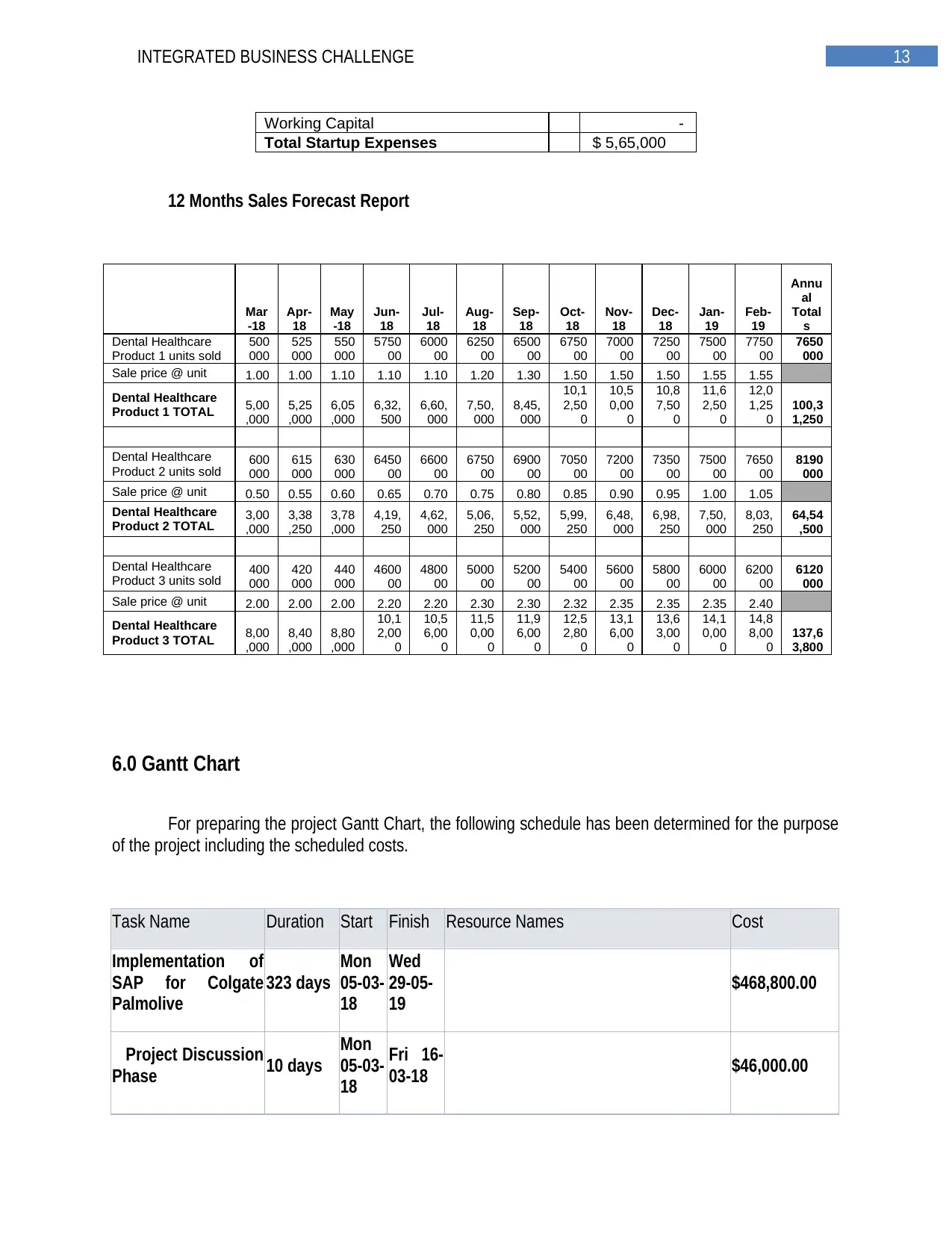
13INTEGRATED BUSINESS CHALLENGE
Working Capital -
Total Startup Expenses $ 5,65,000
12 Months Sales Forecast Report
Mar
-18
Apr-
18
May
-18
Jun-
18
Jul-
18
Aug-
18
Sep-
18
Oct-
18
Nov-
18
Dec-
18
Jan-
19
Feb-
19
Annu
al
Total
s
Dental Healthcare
Product 1 units sold
500
000
525
000
550
000
5750
00
6000
00
6250
00
6500
00
6750
00
7000
00
7250
00
7500
00
7750
00
7650
000
Sale price @ unit 1.00 1.00 1.10 1.10 1.10 1.20 1.30 1.50 1.50 1.50 1.55 1.55
Dental Healthcare
Product 1 TOTAL 5,00
,000
5,25
,000
6,05
,000
6,32,
500
6,60,
000
7,50,
000
8,45,
000
10,1
2,50
0
10,5
0,00
0
10,8
7,50
0
11,6
2,50
0
12,0
1,25
0
100,3
1,250
Dental Healthcare
Product 2 units sold 600
000
615
000
630
000
6450
00
6600
00
6750
00
6900
00
7050
00
7200
00
7350
00
7500
00
7650
00
8190
000
Sale price @ unit 0.50 0.55 0.60 0.65 0.70 0.75 0.80 0.85 0.90 0.95 1.00 1.05
Dental Healthcare
Product 2 TOTAL 3,00
,000
3,38
,250
3,78
,000
4,19,
250
4,62,
000
5,06,
250
5,52,
000
5,99,
250
6,48,
000
6,98,
250
7,50,
000
8,03,
250
64,54
,500
Dental Healthcare
Product 3 units sold 400
000
420
000
440
000
4600
00
4800
00
5000
00
5200
00
5400
00
5600
00
5800
00
6000
00
6200
00
6120
000
Sale price @ unit 2.00 2.00 2.00 2.20 2.20 2.30 2.30 2.32 2.35 2.35 2.35 2.40
Dental Healthcare
Product 3 TOTAL 8,00
,000
8,40
,000
8,80
,000
10,1
2,00
0
10,5
6,00
0
11,5
0,00
0
11,9
6,00
0
12,5
2,80
0
13,1
6,00
0
13,6
3,00
0
14,1
0,00
0
14,8
8,00
0
137,6
3,800
6.0 Gantt Chart
For preparing the project Gantt Chart, the following schedule has been determined for the purpose
of the project including the scheduled costs.
Task Name Duration Start Finish Resource Names Cost
Implementation of
SAP for Colgate
Palmolive
323 days
Mon
05-03-
18
Wed
29-05-
19
$468,800.00
Project Discussion
Phase 10 days
Mon
05-03-
18
Fri 16-
03-18 $46,000.00
Working Capital -
Total Startup Expenses $ 5,65,000
12 Months Sales Forecast Report
Mar
-18
Apr-
18
May
-18
Jun-
18
Jul-
18
Aug-
18
Sep-
18
Oct-
18
Nov-
18
Dec-
18
Jan-
19
Feb-
19
Annu
al
Total
s
Dental Healthcare
Product 1 units sold
500
000
525
000
550
000
5750
00
6000
00
6250
00
6500
00
6750
00
7000
00
7250
00
7500
00
7750
00
7650
000
Sale price @ unit 1.00 1.00 1.10 1.10 1.10 1.20 1.30 1.50 1.50 1.50 1.55 1.55
Dental Healthcare
Product 1 TOTAL 5,00
,000
5,25
,000
6,05
,000
6,32,
500
6,60,
000
7,50,
000
8,45,
000
10,1
2,50
0
10,5
0,00
0
10,8
7,50
0
11,6
2,50
0
12,0
1,25
0
100,3
1,250
Dental Healthcare
Product 2 units sold 600
000
615
000
630
000
6450
00
6600
00
6750
00
6900
00
7050
00
7200
00
7350
00
7500
00
7650
00
8190
000
Sale price @ unit 0.50 0.55 0.60 0.65 0.70 0.75 0.80 0.85 0.90 0.95 1.00 1.05
Dental Healthcare
Product 2 TOTAL 3,00
,000
3,38
,250
3,78
,000
4,19,
250
4,62,
000
5,06,
250
5,52,
000
5,99,
250
6,48,
000
6,98,
250
7,50,
000
8,03,
250
64,54
,500
Dental Healthcare
Product 3 units sold 400
000
420
000
440
000
4600
00
4800
00
5000
00
5200
00
5400
00
5600
00
5800
00
6000
00
6200
00
6120
000
Sale price @ unit 2.00 2.00 2.00 2.20 2.20 2.30 2.30 2.32 2.35 2.35 2.35 2.40
Dental Healthcare
Product 3 TOTAL 8,00
,000
8,40
,000
8,80
,000
10,1
2,00
0
10,5
6,00
0
11,5
0,00
0
11,9
6,00
0
12,5
2,80
0
13,1
6,00
0
13,6
3,00
0
14,1
0,00
0
14,8
8,00
0
137,6
3,800
6.0 Gantt Chart
For preparing the project Gantt Chart, the following schedule has been determined for the purpose
of the project including the scheduled costs.
Task Name Duration Start Finish Resource Names Cost
Implementation of
SAP for Colgate
Palmolive
323 days
Mon
05-03-
18
Wed
29-05-
19
$468,800.00
Project Discussion
Phase 10 days
Mon
05-03-
18
Fri 16-
03-18 $46,000.00

14INTEGRATED BUSINESS CHALLENGE
Board Meetings
and Discussions 3 days
Mon
05-03-
18
Wed
07-03-
18
Finance Manager, Procurement
Manager, Project Manager, Project
Planner
$13,800.00
Issues
identification 4 days
Thu
08-03-
18
Tue 13-
03-18
Finance Manager, Procurement
Manager, Project Manager, Project
Planner
$18,400.00
Solutions
identification 1 day
Wed
14-03-
18
Wed
14-03-
18
Finance Manager, Procurement
Manager, Project Manager, Project
Planner
$4,600.00
Selection of SAP
as the feasible
solution
1 day
Thu
15-03-
18
Thu 15-
03-18
Finance Manager, Procurement
Manager, Project Manager, Project
Planner
$4,600.00
Board Meeting
regarding SAP
implementation
1 day Fri 16-
03-18
Fri 16-
03-18
Finance Manager, Procurement
Manager, Project Manager, Project
Planner
$4,600.00
Authorization of
Project 0 days Fri 16-
03-18
Fri 16-
03-18 Project Manager $0.00
Project Planning
Phase 104 days
Mon
19-03-
18
Thu 09-
08-18 $162,200.00
Early planning
and development 10 days
Mon
19-03-
18
Fri 30-
03-18
Project Manager, Project Planner, Project
Supervisor $38,000.00
Hire SAP
consultancy 5 days
Mon
02-04-
18
Fri 06-
04-18 Project Manager, Project Planner $12,000.00
Meeting for SAP
implementation 5 days
Mon
09-04-
18
Fri 13-
04-18 Project Manager, Project Planner $12,000.00
Project feasibility
testing 5 days
Mon
16-04-
18
Fri 20-
04-18 Project Planner, Project Supervisor $11,000.00
Cost benefit
analysis 10 days
Mon
23-04-
18
Fri 04-
05-18 Project Planner, Project Supervisor $22,000.00
Project approval 5 days Mon Fri 11- Project Manager $8,000.00
Board Meetings
and Discussions 3 days
Mon
05-03-
18
Wed
07-03-
18
Finance Manager, Procurement
Manager, Project Manager, Project
Planner
$13,800.00
Issues
identification 4 days
Thu
08-03-
18
Tue 13-
03-18
Finance Manager, Procurement
Manager, Project Manager, Project
Planner
$18,400.00
Solutions
identification 1 day
Wed
14-03-
18
Wed
14-03-
18
Finance Manager, Procurement
Manager, Project Manager, Project
Planner
$4,600.00
Selection of SAP
as the feasible
solution
1 day
Thu
15-03-
18
Thu 15-
03-18
Finance Manager, Procurement
Manager, Project Manager, Project
Planner
$4,600.00
Board Meeting
regarding SAP
implementation
1 day Fri 16-
03-18
Fri 16-
03-18
Finance Manager, Procurement
Manager, Project Manager, Project
Planner
$4,600.00
Authorization of
Project 0 days Fri 16-
03-18
Fri 16-
03-18 Project Manager $0.00
Project Planning
Phase 104 days
Mon
19-03-
18
Thu 09-
08-18 $162,200.00
Early planning
and development 10 days
Mon
19-03-
18
Fri 30-
03-18
Project Manager, Project Planner, Project
Supervisor $38,000.00
Hire SAP
consultancy 5 days
Mon
02-04-
18
Fri 06-
04-18 Project Manager, Project Planner $12,000.00
Meeting for SAP
implementation 5 days
Mon
09-04-
18
Fri 13-
04-18 Project Manager, Project Planner $12,000.00
Project feasibility
testing 5 days
Mon
16-04-
18
Fri 20-
04-18 Project Planner, Project Supervisor $11,000.00
Cost benefit
analysis 10 days
Mon
23-04-
18
Fri 04-
05-18 Project Planner, Project Supervisor $22,000.00
Project approval 5 days Mon Fri 11- Project Manager $8,000.00
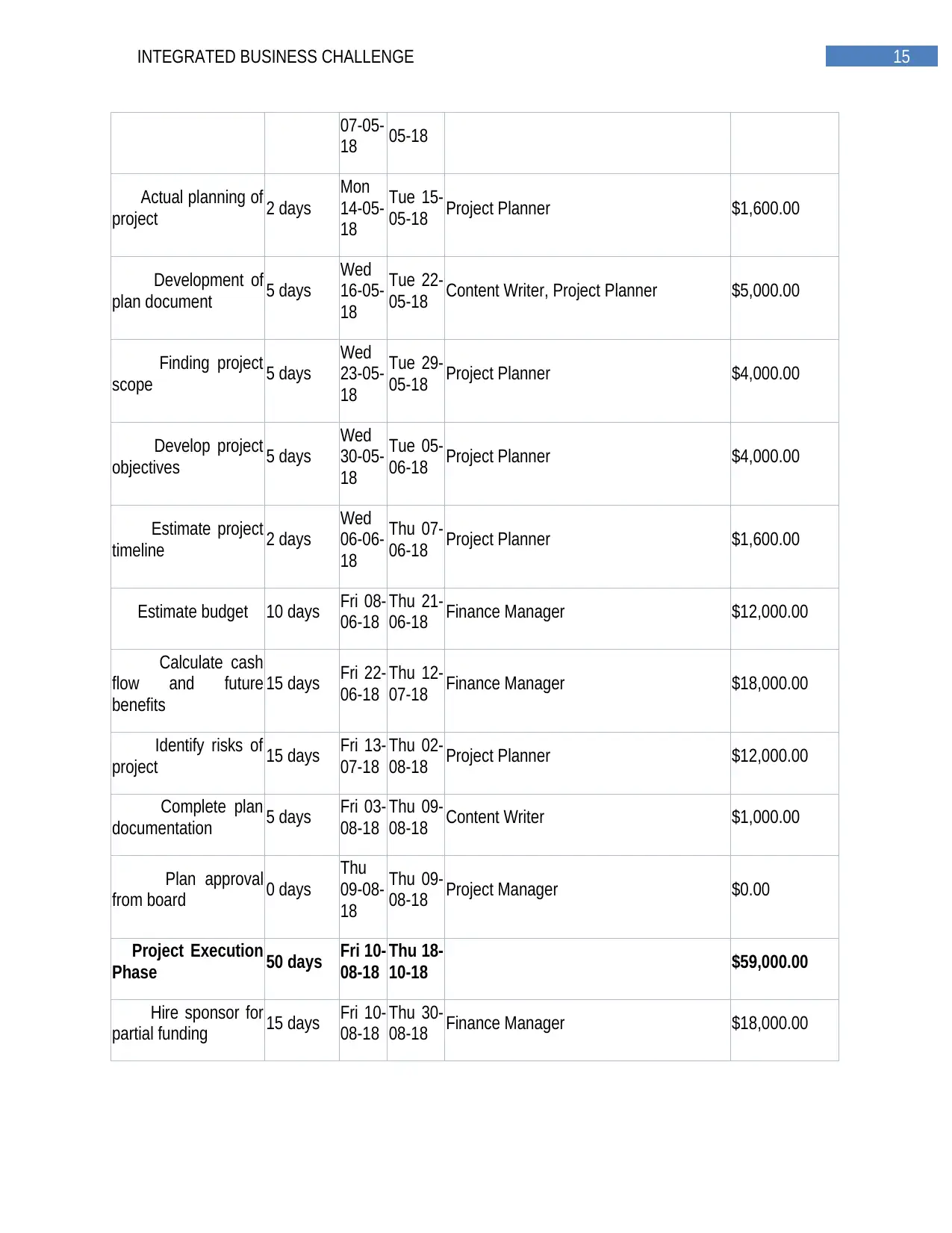
15INTEGRATED BUSINESS CHALLENGE
07-05-
18 05-18
Actual planning of
project 2 days
Mon
14-05-
18
Tue 15-
05-18 Project Planner $1,600.00
Development of
plan document 5 days
Wed
16-05-
18
Tue 22-
05-18 Content Writer, Project Planner $5,000.00
Finding project
scope 5 days
Wed
23-05-
18
Tue 29-
05-18 Project Planner $4,000.00
Develop project
objectives 5 days
Wed
30-05-
18
Tue 05-
06-18 Project Planner $4,000.00
Estimate project
timeline 2 days
Wed
06-06-
18
Thu 07-
06-18 Project Planner $1,600.00
Estimate budget 10 days Fri 08-
06-18
Thu 21-
06-18 Finance Manager $12,000.00
Calculate cash
flow and future
benefits
15 days Fri 22-
06-18
Thu 12-
07-18 Finance Manager $18,000.00
Identify risks of
project 15 days Fri 13-
07-18
Thu 02-
08-18 Project Planner $12,000.00
Complete plan
documentation 5 days Fri 03-
08-18
Thu 09-
08-18 Content Writer $1,000.00
Plan approval
from board 0 days
Thu
09-08-
18
Thu 09-
08-18 Project Manager $0.00
Project Execution
Phase 50 days Fri 10-
08-18
Thu 18-
10-18 $59,000.00
Hire sponsor for
partial funding 15 days Fri 10-
08-18
Thu 30-
08-18 Finance Manager $18,000.00
07-05-
18 05-18
Actual planning of
project 2 days
Mon
14-05-
18
Tue 15-
05-18 Project Planner $1,600.00
Development of
plan document 5 days
Wed
16-05-
18
Tue 22-
05-18 Content Writer, Project Planner $5,000.00
Finding project
scope 5 days
Wed
23-05-
18
Tue 29-
05-18 Project Planner $4,000.00
Develop project
objectives 5 days
Wed
30-05-
18
Tue 05-
06-18 Project Planner $4,000.00
Estimate project
timeline 2 days
Wed
06-06-
18
Thu 07-
06-18 Project Planner $1,600.00
Estimate budget 10 days Fri 08-
06-18
Thu 21-
06-18 Finance Manager $12,000.00
Calculate cash
flow and future
benefits
15 days Fri 22-
06-18
Thu 12-
07-18 Finance Manager $18,000.00
Identify risks of
project 15 days Fri 13-
07-18
Thu 02-
08-18 Project Planner $12,000.00
Complete plan
documentation 5 days Fri 03-
08-18
Thu 09-
08-18 Content Writer $1,000.00
Plan approval
from board 0 days
Thu
09-08-
18
Thu 09-
08-18 Project Manager $0.00
Project Execution
Phase 50 days Fri 10-
08-18
Thu 18-
10-18 $59,000.00
Hire sponsor for
partial funding 15 days Fri 10-
08-18
Thu 30-
08-18 Finance Manager $18,000.00
Secure Best Marks with AI Grader
Need help grading? Try our AI Grader for instant feedback on your assignments.
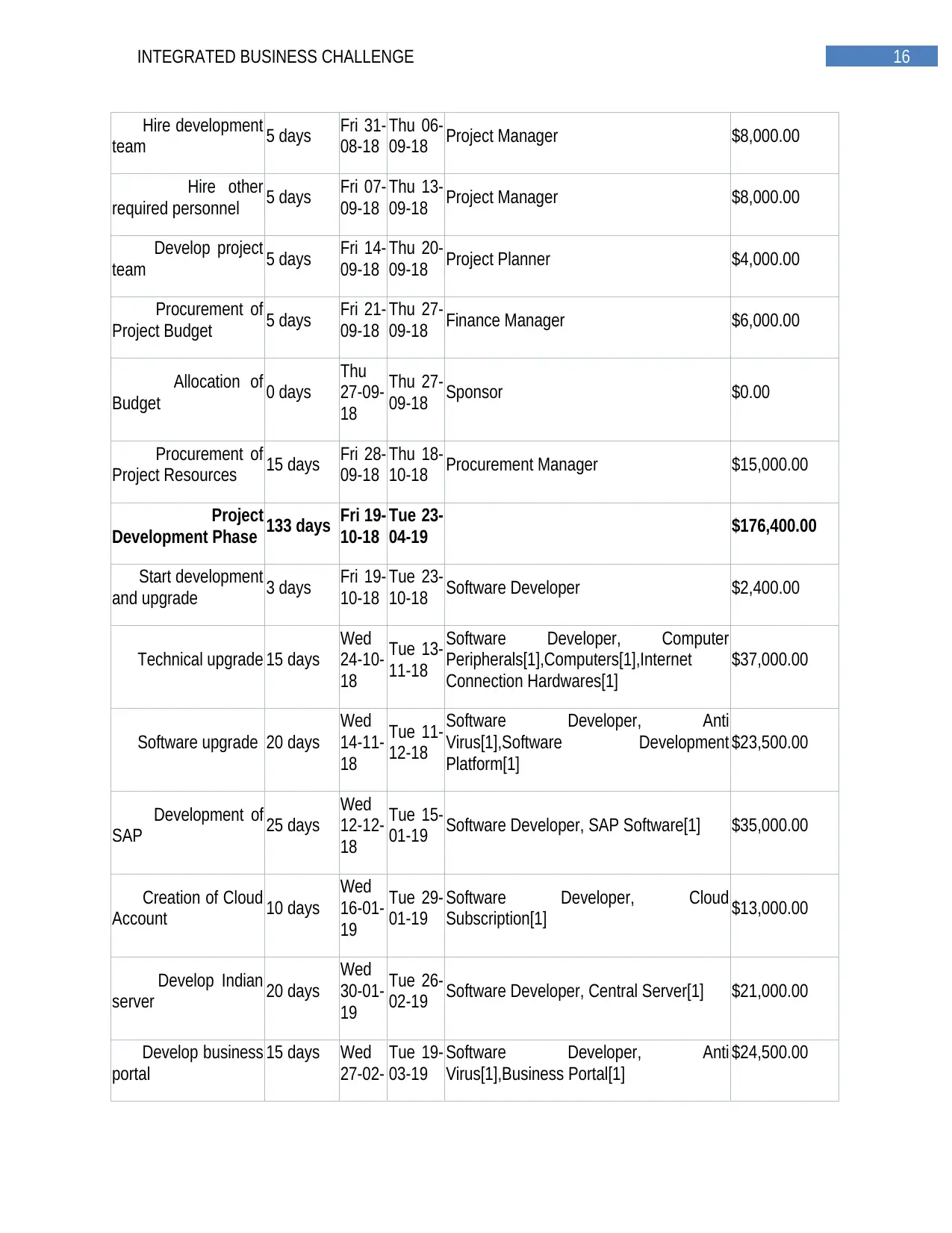
16INTEGRATED BUSINESS CHALLENGE
Hire development
team 5 days Fri 31-
08-18
Thu 06-
09-18 Project Manager $8,000.00
Hire other
required personnel 5 days Fri 07-
09-18
Thu 13-
09-18 Project Manager $8,000.00
Develop project
team 5 days Fri 14-
09-18
Thu 20-
09-18 Project Planner $4,000.00
Procurement of
Project Budget 5 days Fri 21-
09-18
Thu 27-
09-18 Finance Manager $6,000.00
Allocation of
Budget 0 days
Thu
27-09-
18
Thu 27-
09-18 Sponsor $0.00
Procurement of
Project Resources 15 days Fri 28-
09-18
Thu 18-
10-18 Procurement Manager $15,000.00
Project
Development Phase 133 days Fri 19-
10-18
Tue 23-
04-19 $176,400.00
Start development
and upgrade 3 days Fri 19-
10-18
Tue 23-
10-18 Software Developer $2,400.00
Technical upgrade 15 days
Wed
24-10-
18
Tue 13-
11-18
Software Developer, Computer
Peripherals[1],Computers[1],Internet
Connection Hardwares[1]
$37,000.00
Software upgrade 20 days
Wed
14-11-
18
Tue 11-
12-18
Software Developer, Anti
Virus[1],Software Development
Platform[1]
$23,500.00
Development of
SAP 25 days
Wed
12-12-
18
Tue 15-
01-19 Software Developer, SAP Software[1] $35,000.00
Creation of Cloud
Account 10 days
Wed
16-01-
19
Tue 29-
01-19
Software Developer, Cloud
Subscription[1] $13,000.00
Develop Indian
server 20 days
Wed
30-01-
19
Tue 26-
02-19 Software Developer, Central Server[1] $21,000.00
Develop business
portal
15 days Wed
27-02-
Tue 19-
03-19
Software Developer, Anti
Virus[1],Business Portal[1]
$24,500.00
Hire development
team 5 days Fri 31-
08-18
Thu 06-
09-18 Project Manager $8,000.00
Hire other
required personnel 5 days Fri 07-
09-18
Thu 13-
09-18 Project Manager $8,000.00
Develop project
team 5 days Fri 14-
09-18
Thu 20-
09-18 Project Planner $4,000.00
Procurement of
Project Budget 5 days Fri 21-
09-18
Thu 27-
09-18 Finance Manager $6,000.00
Allocation of
Budget 0 days
Thu
27-09-
18
Thu 27-
09-18 Sponsor $0.00
Procurement of
Project Resources 15 days Fri 28-
09-18
Thu 18-
10-18 Procurement Manager $15,000.00
Project
Development Phase 133 days Fri 19-
10-18
Tue 23-
04-19 $176,400.00
Start development
and upgrade 3 days Fri 19-
10-18
Tue 23-
10-18 Software Developer $2,400.00
Technical upgrade 15 days
Wed
24-10-
18
Tue 13-
11-18
Software Developer, Computer
Peripherals[1],Computers[1],Internet
Connection Hardwares[1]
$37,000.00
Software upgrade 20 days
Wed
14-11-
18
Tue 11-
12-18
Software Developer, Anti
Virus[1],Software Development
Platform[1]
$23,500.00
Development of
SAP 25 days
Wed
12-12-
18
Tue 15-
01-19 Software Developer, SAP Software[1] $35,000.00
Creation of Cloud
Account 10 days
Wed
16-01-
19
Tue 29-
01-19
Software Developer, Cloud
Subscription[1] $13,000.00
Develop Indian
server 20 days
Wed
30-01-
19
Tue 26-
02-19 Software Developer, Central Server[1] $21,000.00
Develop business
portal
15 days Wed
27-02-
Tue 19-
03-19
Software Developer, Anti
Virus[1],Business Portal[1]
$24,500.00
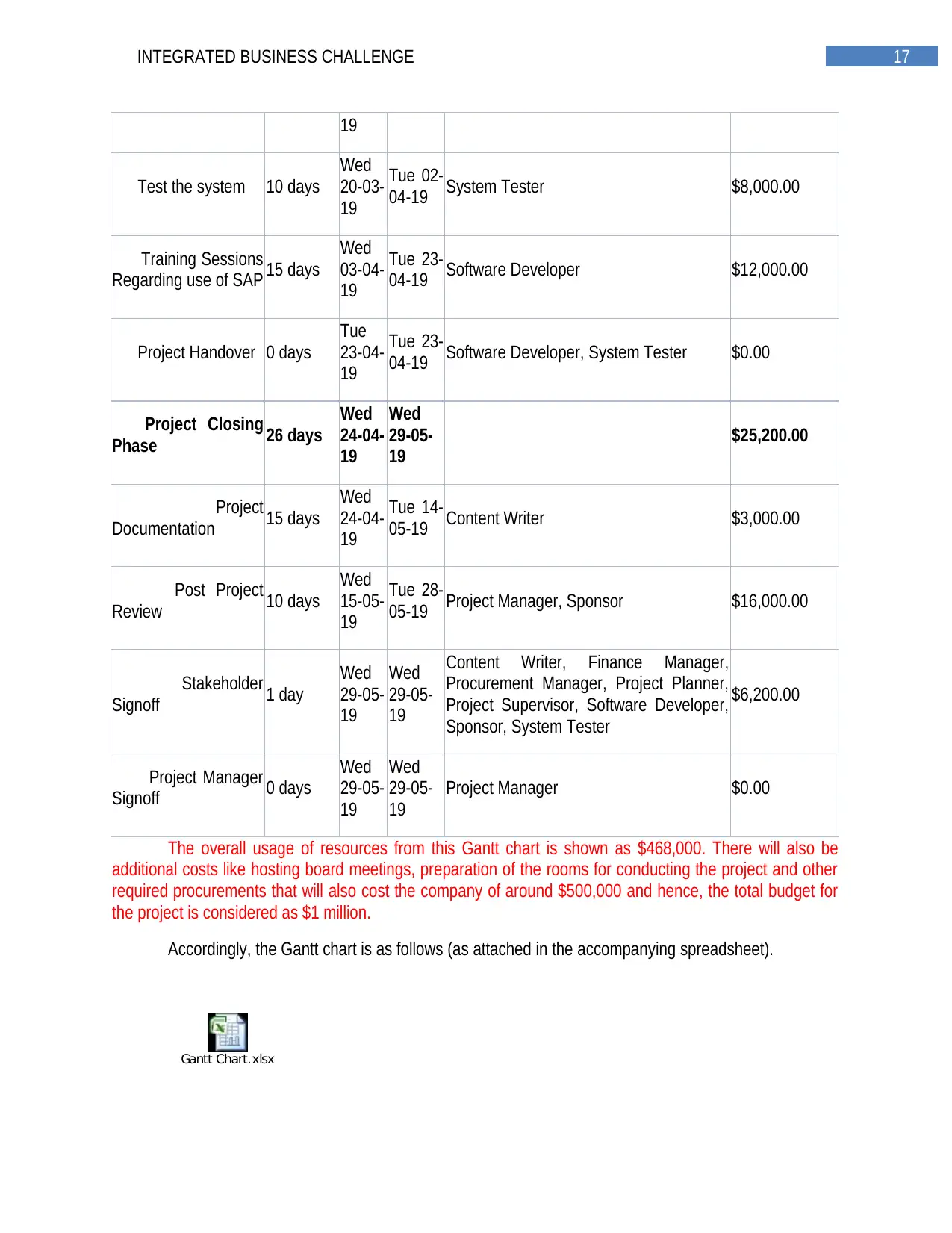
17INTEGRATED BUSINESS CHALLENGE
19
Test the system 10 days
Wed
20-03-
19
Tue 02-
04-19 System Tester $8,000.00
Training Sessions
Regarding use of SAP 15 days
Wed
03-04-
19
Tue 23-
04-19 Software Developer $12,000.00
Project Handover 0 days
Tue
23-04-
19
Tue 23-
04-19 Software Developer, System Tester $0.00
Project Closing
Phase 26 days
Wed
24-04-
19
Wed
29-05-
19
$25,200.00
Project
Documentation 15 days
Wed
24-04-
19
Tue 14-
05-19 Content Writer $3,000.00
Post Project
Review 10 days
Wed
15-05-
19
Tue 28-
05-19 Project Manager, Sponsor $16,000.00
Stakeholder
Signoff 1 day
Wed
29-05-
19
Wed
29-05-
19
Content Writer, Finance Manager,
Procurement Manager, Project Planner,
Project Supervisor, Software Developer,
Sponsor, System Tester
$6,200.00
Project Manager
Signoff 0 days
Wed
29-05-
19
Wed
29-05-
19
Project Manager $0.00
The overall usage of resources from this Gantt chart is shown as $468,000. There will also be
additional costs like hosting board meetings, preparation of the rooms for conducting the project and other
required procurements that will also cost the company of around $500,000 and hence, the total budget for
the project is considered as $1 million.
Accordingly, the Gantt chart is as follows (as attached in the accompanying spreadsheet).
Gantt Chart.xlsx
19
Test the system 10 days
Wed
20-03-
19
Tue 02-
04-19 System Tester $8,000.00
Training Sessions
Regarding use of SAP 15 days
Wed
03-04-
19
Tue 23-
04-19 Software Developer $12,000.00
Project Handover 0 days
Tue
23-04-
19
Tue 23-
04-19 Software Developer, System Tester $0.00
Project Closing
Phase 26 days
Wed
24-04-
19
Wed
29-05-
19
$25,200.00
Project
Documentation 15 days
Wed
24-04-
19
Tue 14-
05-19 Content Writer $3,000.00
Post Project
Review 10 days
Wed
15-05-
19
Tue 28-
05-19 Project Manager, Sponsor $16,000.00
Stakeholder
Signoff 1 day
Wed
29-05-
19
Wed
29-05-
19
Content Writer, Finance Manager,
Procurement Manager, Project Planner,
Project Supervisor, Software Developer,
Sponsor, System Tester
$6,200.00
Project Manager
Signoff 0 days
Wed
29-05-
19
Wed
29-05-
19
Project Manager $0.00
The overall usage of resources from this Gantt chart is shown as $468,000. There will also be
additional costs like hosting board meetings, preparation of the rooms for conducting the project and other
required procurements that will also cost the company of around $500,000 and hence, the total budget for
the project is considered as $1 million.
Accordingly, the Gantt chart is as follows (as attached in the accompanying spreadsheet).
Gantt Chart.xlsx

18INTEGRATED BUSINESS CHALLENGE
7.0 Resources
The resource usage including both material and human resources is shown in the following table.
Resource Name Type Material Label Initials Group Max. Units Std. Rate
Project Manager Work P 100% $200.00/hr
Project Supervisor Work P 100% $175.00/hr
Sponsor Work S 100% $0.00/hr
Finance Manager Work F 100% $150.00/hr
Software Developer Work S 100% $100.00/hr
System Tester Work S 100% $100.00/hr
Procurement Manager Work P 100% $125.00/hr
Project Planner Work P 100% $100.00/hr
Content Writer Work C 100% $25.00/hr
Computers Material C $15,000.00
Computer Peripherals Material C $5,000.00
Internet Connection
Hardwares Material I $5,000.00
Software Development
Platform Material S $5,000.00
SAP Software Material S $15,000.00
Anti Virus Material A $2,500.00
Business Portal Material B $10,000.00
Cloud Subscription Material C $5,000.00
Central Server Material C $5,000.00
7.0 Resources
The resource usage including both material and human resources is shown in the following table.
Resource Name Type Material Label Initials Group Max. Units Std. Rate
Project Manager Work P 100% $200.00/hr
Project Supervisor Work P 100% $175.00/hr
Sponsor Work S 100% $0.00/hr
Finance Manager Work F 100% $150.00/hr
Software Developer Work S 100% $100.00/hr
System Tester Work S 100% $100.00/hr
Procurement Manager Work P 100% $125.00/hr
Project Planner Work P 100% $100.00/hr
Content Writer Work C 100% $25.00/hr
Computers Material C $15,000.00
Computer Peripherals Material C $5,000.00
Internet Connection
Hardwares Material I $5,000.00
Software Development
Platform Material S $5,000.00
SAP Software Material S $15,000.00
Anti Virus Material A $2,500.00
Business Portal Material B $10,000.00
Cloud Subscription Material C $5,000.00
Central Server Material C $5,000.00
Paraphrase This Document
Need a fresh take? Get an instant paraphrase of this document with our AI Paraphraser
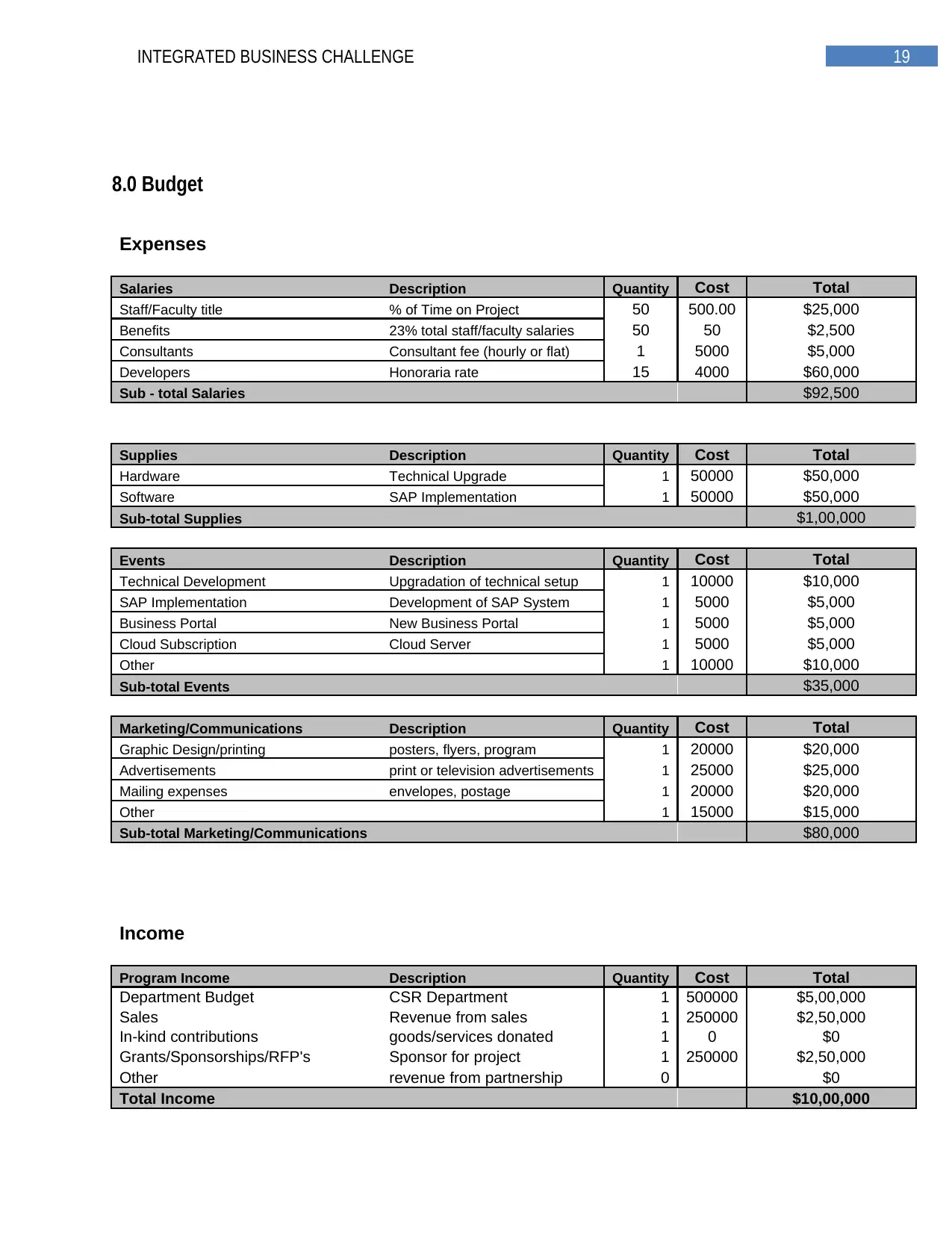
19INTEGRATED BUSINESS CHALLENGE
8.0 Budget
Expenses
Salaries Description Quantity Cost Total
Staff/Faculty title % of Time on Project 50 500.00 $25,000
Benefits 23% total staff/faculty salaries 50 50 $2,500
Consultants Consultant fee (hourly or flat) 1 5000 $5,000
Developers Honoraria rate 15 4000 $60,000
Sub - total Salaries $92,500
Supplies Description Quantity Cost Total
Hardware Technical Upgrade 1 50000 $50,000
Software SAP Implementation 1 50000 $50,000
Sub-total Supplies $1,00,000
Events Description Quantity Cost Total
Technical Development Upgradation of technical setup 1 10000 $10,000
SAP Implementation Development of SAP System 1 5000 $5,000
Business Portal New Business Portal 1 5000 $5,000
Cloud Subscription Cloud Server 1 5000 $5,000
Other 1 10000 $10,000
Sub-total Events $35,000
Marketing/Communications Description Quantity Cost Total
Graphic Design/printing posters, flyers, program 1 20000 $20,000
Advertisements print or television advertisements 1 25000 $25,000
Mailing expenses envelopes, postage 1 20000 $20,000
Other 1 15000 $15,000
Sub-total Marketing/Communications $80,000
Income
Program Income Description Quantity Cost Total
Department Budget CSR Department 1 500000 $5,00,000
Sales Revenue from sales 1 250000 $2,50,000
In-kind contributions goods/services donated 1 0 $0
Grants/Sponsorships/RFP's Sponsor for project 1 250000 $2,50,000
Other revenue from partnership 0 $0
Total Income $10,00,000
8.0 Budget
Expenses
Salaries Description Quantity Cost Total
Staff/Faculty title % of Time on Project 50 500.00 $25,000
Benefits 23% total staff/faculty salaries 50 50 $2,500
Consultants Consultant fee (hourly or flat) 1 5000 $5,000
Developers Honoraria rate 15 4000 $60,000
Sub - total Salaries $92,500
Supplies Description Quantity Cost Total
Hardware Technical Upgrade 1 50000 $50,000
Software SAP Implementation 1 50000 $50,000
Sub-total Supplies $1,00,000
Events Description Quantity Cost Total
Technical Development Upgradation of technical setup 1 10000 $10,000
SAP Implementation Development of SAP System 1 5000 $5,000
Business Portal New Business Portal 1 5000 $5,000
Cloud Subscription Cloud Server 1 5000 $5,000
Other 1 10000 $10,000
Sub-total Events $35,000
Marketing/Communications Description Quantity Cost Total
Graphic Design/printing posters, flyers, program 1 20000 $20,000
Advertisements print or television advertisements 1 25000 $25,000
Mailing expenses envelopes, postage 1 20000 $20,000
Other 1 15000 $15,000
Sub-total Marketing/Communications $80,000
Income
Program Income Description Quantity Cost Total
Department Budget CSR Department 1 500000 $5,00,000
Sales Revenue from sales 1 250000 $2,50,000
In-kind contributions goods/services donated 1 0 $0
Grants/Sponsorships/RFP's Sponsor for project 1 250000 $2,50,000
Other revenue from partnership 0 $0
Total Income $10,00,000
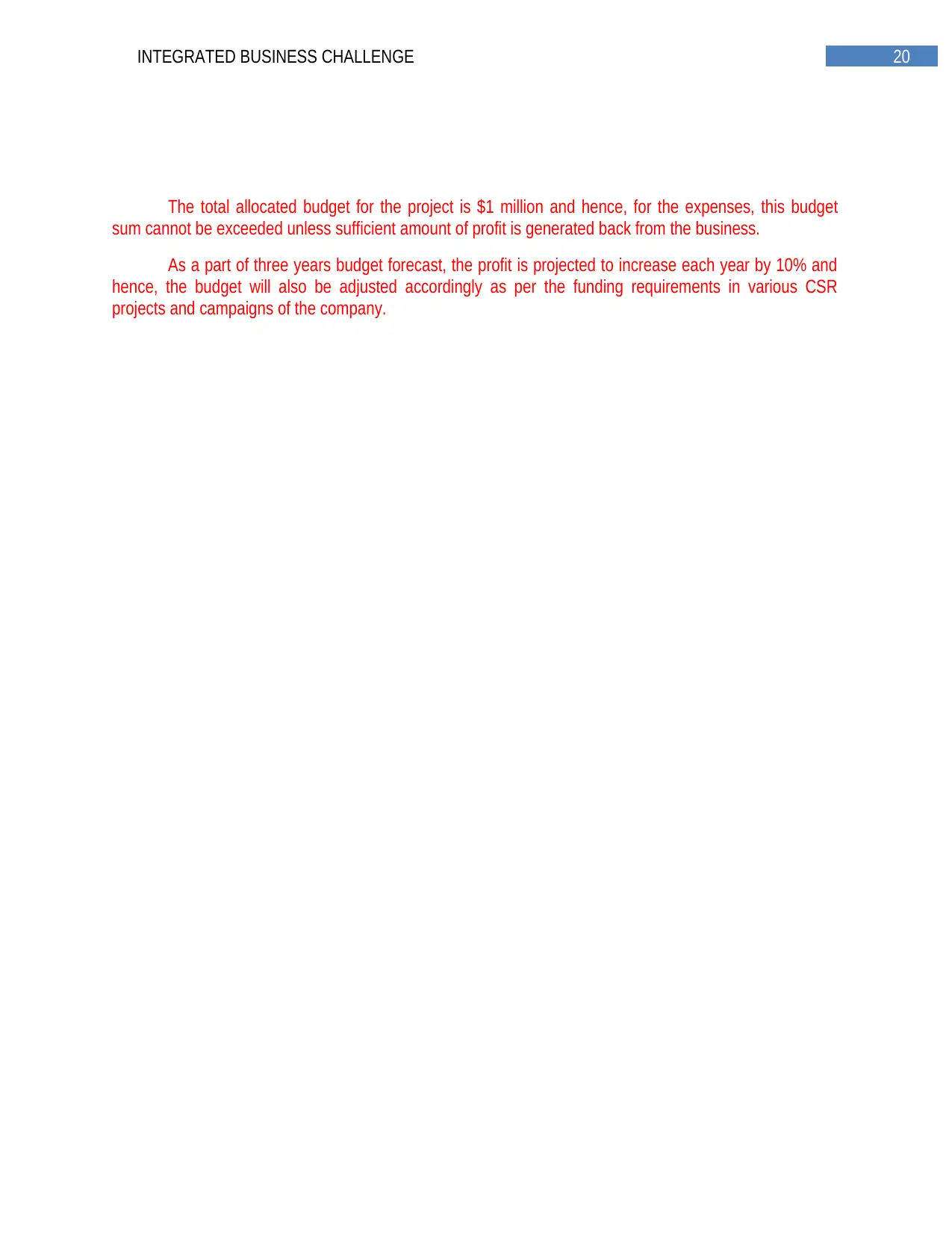
20INTEGRATED BUSINESS CHALLENGE
The total allocated budget for the project is $1 million and hence, for the expenses, this budget
sum cannot be exceeded unless sufficient amount of profit is generated back from the business.
As a part of three years budget forecast, the profit is projected to increase each year by 10% and
hence, the budget will also be adjusted accordingly as per the funding requirements in various CSR
projects and campaigns of the company.
The total allocated budget for the project is $1 million and hence, for the expenses, this budget
sum cannot be exceeded unless sufficient amount of profit is generated back from the business.
As a part of three years budget forecast, the profit is projected to increase each year by 10% and
hence, the budget will also be adjusted accordingly as per the funding requirements in various CSR
projects and campaigns of the company.
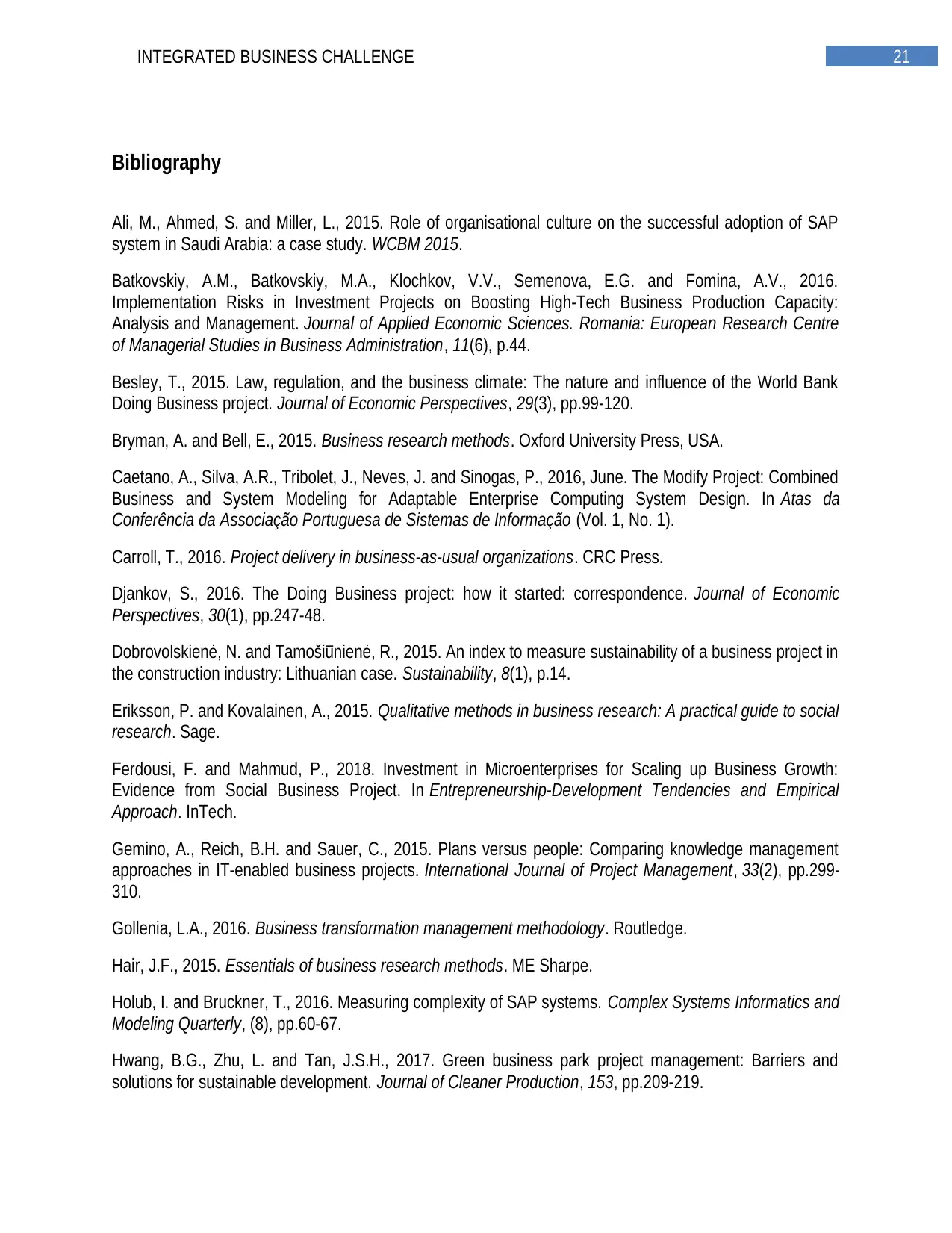
21INTEGRATED BUSINESS CHALLENGE
Bibliography
Ali, M., Ahmed, S. and Miller, L., 2015. Role of organisational culture on the successful adoption of SAP
system in Saudi Arabia: a case study. WCBM 2015.
Batkovskiy, A.M., Batkovskiy, M.A., Klochkov, V.V., Semenova, E.G. and Fomina, A.V., 2016.
Implementation Risks in Investment Projects on Boosting High-Tech Business Production Capacity:
Analysis and Management. Journal of Applied Economic Sciences. Romania: European Research Centre
of Managerial Studies in Business Administration, 11(6), p.44.
Besley, T., 2015. Law, regulation, and the business climate: The nature and influence of the World Bank
Doing Business project. Journal of Economic Perspectives, 29(3), pp.99-120.
Bryman, A. and Bell, E., 2015. Business research methods. Oxford University Press, USA.
Caetano, A., Silva, A.R., Tribolet, J., Neves, J. and Sinogas, P., 2016, June. The Modify Project: Combined
Business and System Modeling for Adaptable Enterprise Computing System Design. In Atas da
Conferência da Associação Portuguesa de Sistemas de Informação (Vol. 1, No. 1).
Carroll, T., 2016. Project delivery in business-as-usual organizations. CRC Press.
Djankov, S., 2016. The Doing Business project: how it started: correspondence. Journal of Economic
Perspectives, 30(1), pp.247-48.
Dobrovolskienė, N. and Tamošiūnienė, R., 2015. An index to measure sustainability of a business project in
the construction industry: Lithuanian case. Sustainability, 8(1), p.14.
Eriksson, P. and Kovalainen, A., 2015. Qualitative methods in business research: A practical guide to social
research. Sage.
Ferdousi, F. and Mahmud, P., 2018. Investment in Microenterprises for Scaling up Business Growth:
Evidence from Social Business Project. In Entrepreneurship-Development Tendencies and Empirical
Approach. InTech.
Gemino, A., Reich, B.H. and Sauer, C., 2015. Plans versus people: Comparing knowledge management
approaches in IT-enabled business projects. International Journal of Project Management, 33(2), pp.299-
310.
Gollenia, L.A., 2016. Business transformation management methodology. Routledge.
Hair, J.F., 2015. Essentials of business research methods. ME Sharpe.
Holub, I. and Bruckner, T., 2016. Measuring complexity of SAP systems. Complex Systems Informatics and
Modeling Quarterly, (8), pp.60-67.
Hwang, B.G., Zhu, L. and Tan, J.S.H., 2017. Green business park project management: Barriers and
solutions for sustainable development. Journal of Cleaner Production, 153, pp.209-219.
Bibliography
Ali, M., Ahmed, S. and Miller, L., 2015. Role of organisational culture on the successful adoption of SAP
system in Saudi Arabia: a case study. WCBM 2015.
Batkovskiy, A.M., Batkovskiy, M.A., Klochkov, V.V., Semenova, E.G. and Fomina, A.V., 2016.
Implementation Risks in Investment Projects on Boosting High-Tech Business Production Capacity:
Analysis and Management. Journal of Applied Economic Sciences. Romania: European Research Centre
of Managerial Studies in Business Administration, 11(6), p.44.
Besley, T., 2015. Law, regulation, and the business climate: The nature and influence of the World Bank
Doing Business project. Journal of Economic Perspectives, 29(3), pp.99-120.
Bryman, A. and Bell, E., 2015. Business research methods. Oxford University Press, USA.
Caetano, A., Silva, A.R., Tribolet, J., Neves, J. and Sinogas, P., 2016, June. The Modify Project: Combined
Business and System Modeling for Adaptable Enterprise Computing System Design. In Atas da
Conferência da Associação Portuguesa de Sistemas de Informação (Vol. 1, No. 1).
Carroll, T., 2016. Project delivery in business-as-usual organizations. CRC Press.
Djankov, S., 2016. The Doing Business project: how it started: correspondence. Journal of Economic
Perspectives, 30(1), pp.247-48.
Dobrovolskienė, N. and Tamošiūnienė, R., 2015. An index to measure sustainability of a business project in
the construction industry: Lithuanian case. Sustainability, 8(1), p.14.
Eriksson, P. and Kovalainen, A., 2015. Qualitative methods in business research: A practical guide to social
research. Sage.
Ferdousi, F. and Mahmud, P., 2018. Investment in Microenterprises for Scaling up Business Growth:
Evidence from Social Business Project. In Entrepreneurship-Development Tendencies and Empirical
Approach. InTech.
Gemino, A., Reich, B.H. and Sauer, C., 2015. Plans versus people: Comparing knowledge management
approaches in IT-enabled business projects. International Journal of Project Management, 33(2), pp.299-
310.
Gollenia, L.A., 2016. Business transformation management methodology. Routledge.
Hair, J.F., 2015. Essentials of business research methods. ME Sharpe.
Holub, I. and Bruckner, T., 2016. Measuring complexity of SAP systems. Complex Systems Informatics and
Modeling Quarterly, (8), pp.60-67.
Hwang, B.G., Zhu, L. and Tan, J.S.H., 2017. Green business park project management: Barriers and
solutions for sustainable development. Journal of Cleaner Production, 153, pp.209-219.
Secure Best Marks with AI Grader
Need help grading? Try our AI Grader for instant feedback on your assignments.
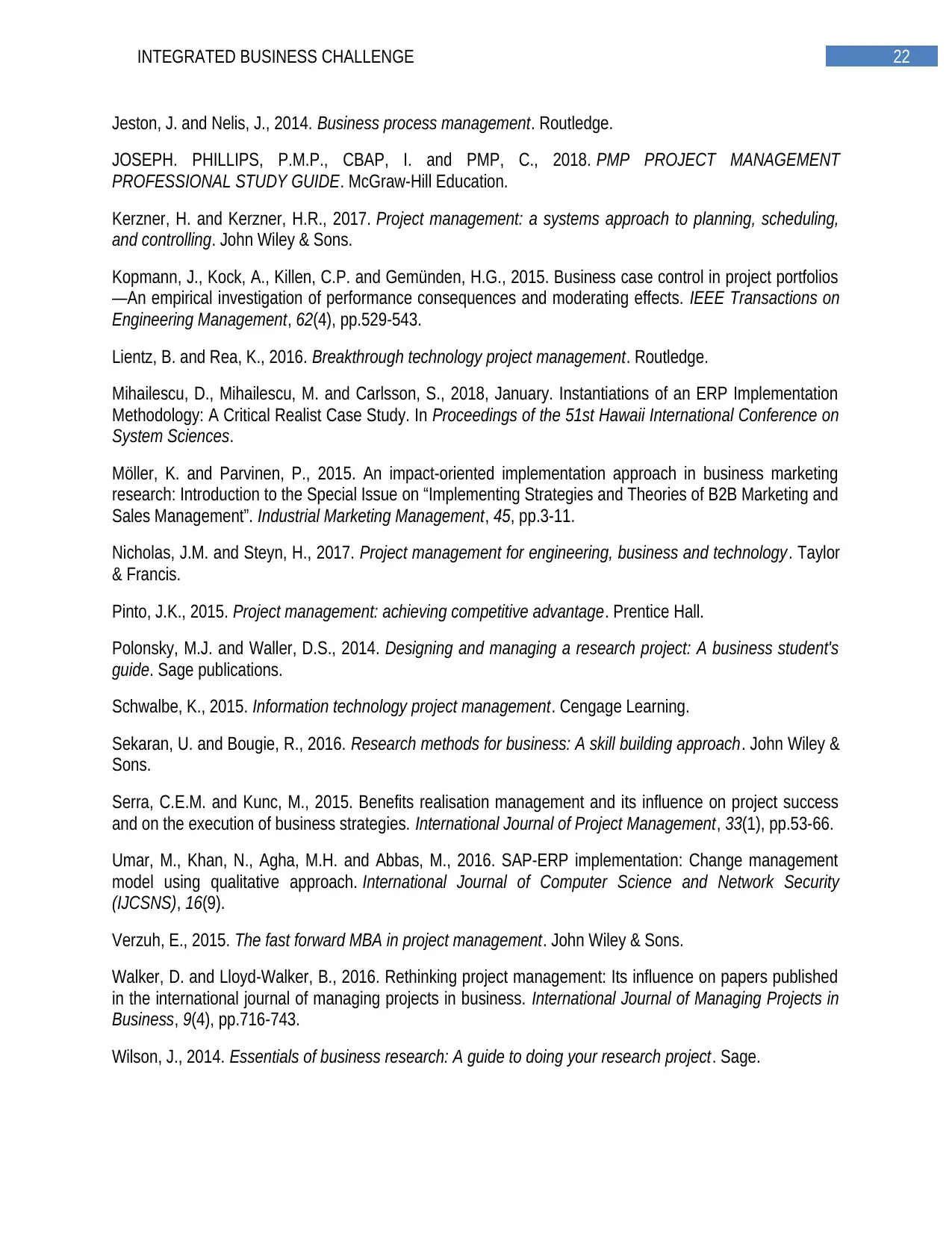
22INTEGRATED BUSINESS CHALLENGE
Jeston, J. and Nelis, J., 2014. Business process management. Routledge.
JOSEPH. PHILLIPS, P.M.P., CBAP, I. and PMP, C., 2018. PMP PROJECT MANAGEMENT
PROFESSIONAL STUDY GUIDE. McGraw-Hill Education.
Kerzner, H. and Kerzner, H.R., 2017. Project management: a systems approach to planning, scheduling,
and controlling. John Wiley & Sons.
Kopmann, J., Kock, A., Killen, C.P. and Gemünden, H.G., 2015. Business case control in project portfolios
—An empirical investigation of performance consequences and moderating effects. IEEE Transactions on
Engineering Management, 62(4), pp.529-543.
Lientz, B. and Rea, K., 2016. Breakthrough technology project management. Routledge.
Mihailescu, D., Mihailescu, M. and Carlsson, S., 2018, January. Instantiations of an ERP Implementation
Methodology: A Critical Realist Case Study. In Proceedings of the 51st Hawaii International Conference on
System Sciences.
Möller, K. and Parvinen, P., 2015. An impact-oriented implementation approach in business marketing
research: Introduction to the Special Issue on “Implementing Strategies and Theories of B2B Marketing and
Sales Management”. Industrial Marketing Management, 45, pp.3-11.
Nicholas, J.M. and Steyn, H., 2017. Project management for engineering, business and technology. Taylor
& Francis.
Pinto, J.K., 2015. Project management: achieving competitive advantage. Prentice Hall.
Polonsky, M.J. and Waller, D.S., 2014. Designing and managing a research project: A business student's
guide. Sage publications.
Schwalbe, K., 2015. Information technology project management. Cengage Learning.
Sekaran, U. and Bougie, R., 2016. Research methods for business: A skill building approach. John Wiley &
Sons.
Serra, C.E.M. and Kunc, M., 2015. Benefits realisation management and its influence on project success
and on the execution of business strategies. International Journal of Project Management, 33(1), pp.53-66.
Umar, M., Khan, N., Agha, M.H. and Abbas, M., 2016. SAP-ERP implementation: Change management
model using qualitative approach. International Journal of Computer Science and Network Security
(IJCSNS), 16(9).
Verzuh, E., 2015. The fast forward MBA in project management. John Wiley & Sons.
Walker, D. and Lloyd-Walker, B., 2016. Rethinking project management: Its influence on papers published
in the international journal of managing projects in business. International Journal of Managing Projects in
Business, 9(4), pp.716-743.
Wilson, J., 2014. Essentials of business research: A guide to doing your research project. Sage.
Jeston, J. and Nelis, J., 2014. Business process management. Routledge.
JOSEPH. PHILLIPS, P.M.P., CBAP, I. and PMP, C., 2018. PMP PROJECT MANAGEMENT
PROFESSIONAL STUDY GUIDE. McGraw-Hill Education.
Kerzner, H. and Kerzner, H.R., 2017. Project management: a systems approach to planning, scheduling,
and controlling. John Wiley & Sons.
Kopmann, J., Kock, A., Killen, C.P. and Gemünden, H.G., 2015. Business case control in project portfolios
—An empirical investigation of performance consequences and moderating effects. IEEE Transactions on
Engineering Management, 62(4), pp.529-543.
Lientz, B. and Rea, K., 2016. Breakthrough technology project management. Routledge.
Mihailescu, D., Mihailescu, M. and Carlsson, S., 2018, January. Instantiations of an ERP Implementation
Methodology: A Critical Realist Case Study. In Proceedings of the 51st Hawaii International Conference on
System Sciences.
Möller, K. and Parvinen, P., 2015. An impact-oriented implementation approach in business marketing
research: Introduction to the Special Issue on “Implementing Strategies and Theories of B2B Marketing and
Sales Management”. Industrial Marketing Management, 45, pp.3-11.
Nicholas, J.M. and Steyn, H., 2017. Project management for engineering, business and technology. Taylor
& Francis.
Pinto, J.K., 2015. Project management: achieving competitive advantage. Prentice Hall.
Polonsky, M.J. and Waller, D.S., 2014. Designing and managing a research project: A business student's
guide. Sage publications.
Schwalbe, K., 2015. Information technology project management. Cengage Learning.
Sekaran, U. and Bougie, R., 2016. Research methods for business: A skill building approach. John Wiley &
Sons.
Serra, C.E.M. and Kunc, M., 2015. Benefits realisation management and its influence on project success
and on the execution of business strategies. International Journal of Project Management, 33(1), pp.53-66.
Umar, M., Khan, N., Agha, M.H. and Abbas, M., 2016. SAP-ERP implementation: Change management
model using qualitative approach. International Journal of Computer Science and Network Security
(IJCSNS), 16(9).
Verzuh, E., 2015. The fast forward MBA in project management. John Wiley & Sons.
Walker, D. and Lloyd-Walker, B., 2016. Rethinking project management: Its influence on papers published
in the international journal of managing projects in business. International Journal of Managing Projects in
Business, 9(4), pp.716-743.
Wilson, J., 2014. Essentials of business research: A guide to doing your research project. Sage.
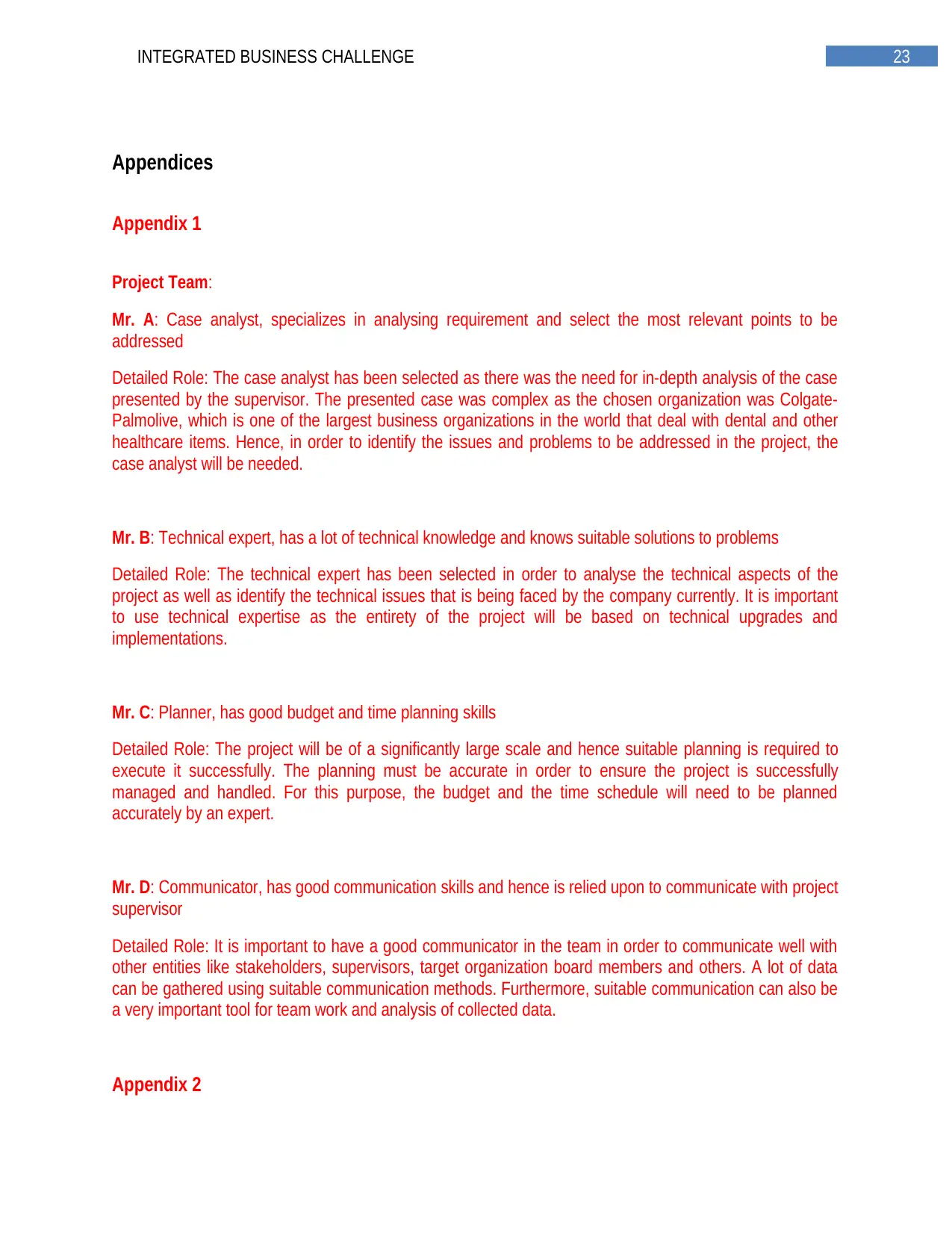
23INTEGRATED BUSINESS CHALLENGE
Appendices
Appendix 1
Project Team:
Mr. A: Case analyst, specializes in analysing requirement and select the most relevant points to be
addressed
Detailed Role: The case analyst has been selected as there was the need for in-depth analysis of the case
presented by the supervisor. The presented case was complex as the chosen organization was Colgate-
Palmolive, which is one of the largest business organizations in the world that deal with dental and other
healthcare items. Hence, in order to identify the issues and problems to be addressed in the project, the
case analyst will be needed.
Mr. B: Technical expert, has a lot of technical knowledge and knows suitable solutions to problems
Detailed Role: The technical expert has been selected in order to analyse the technical aspects of the
project as well as identify the technical issues that is being faced by the company currently. It is important
to use technical expertise as the entirety of the project will be based on technical upgrades and
implementations.
Mr. C: Planner, has good budget and time planning skills
Detailed Role: The project will be of a significantly large scale and hence suitable planning is required to
execute it successfully. The planning must be accurate in order to ensure the project is successfully
managed and handled. For this purpose, the budget and the time schedule will need to be planned
accurately by an expert.
Mr. D: Communicator, has good communication skills and hence is relied upon to communicate with project
supervisor
Detailed Role: It is important to have a good communicator in the team in order to communicate well with
other entities like stakeholders, supervisors, target organization board members and others. A lot of data
can be gathered using suitable communication methods. Furthermore, suitable communication can also be
a very important tool for team work and analysis of collected data.
Appendix 2
Appendices
Appendix 1
Project Team:
Mr. A: Case analyst, specializes in analysing requirement and select the most relevant points to be
addressed
Detailed Role: The case analyst has been selected as there was the need for in-depth analysis of the case
presented by the supervisor. The presented case was complex as the chosen organization was Colgate-
Palmolive, which is one of the largest business organizations in the world that deal with dental and other
healthcare items. Hence, in order to identify the issues and problems to be addressed in the project, the
case analyst will be needed.
Mr. B: Technical expert, has a lot of technical knowledge and knows suitable solutions to problems
Detailed Role: The technical expert has been selected in order to analyse the technical aspects of the
project as well as identify the technical issues that is being faced by the company currently. It is important
to use technical expertise as the entirety of the project will be based on technical upgrades and
implementations.
Mr. C: Planner, has good budget and time planning skills
Detailed Role: The project will be of a significantly large scale and hence suitable planning is required to
execute it successfully. The planning must be accurate in order to ensure the project is successfully
managed and handled. For this purpose, the budget and the time schedule will need to be planned
accurately by an expert.
Mr. D: Communicator, has good communication skills and hence is relied upon to communicate with project
supervisor
Detailed Role: It is important to have a good communicator in the team in order to communicate well with
other entities like stakeholders, supervisors, target organization board members and others. A lot of data
can be gathered using suitable communication methods. Furthermore, suitable communication can also be
a very important tool for team work and analysis of collected data.
Appendix 2
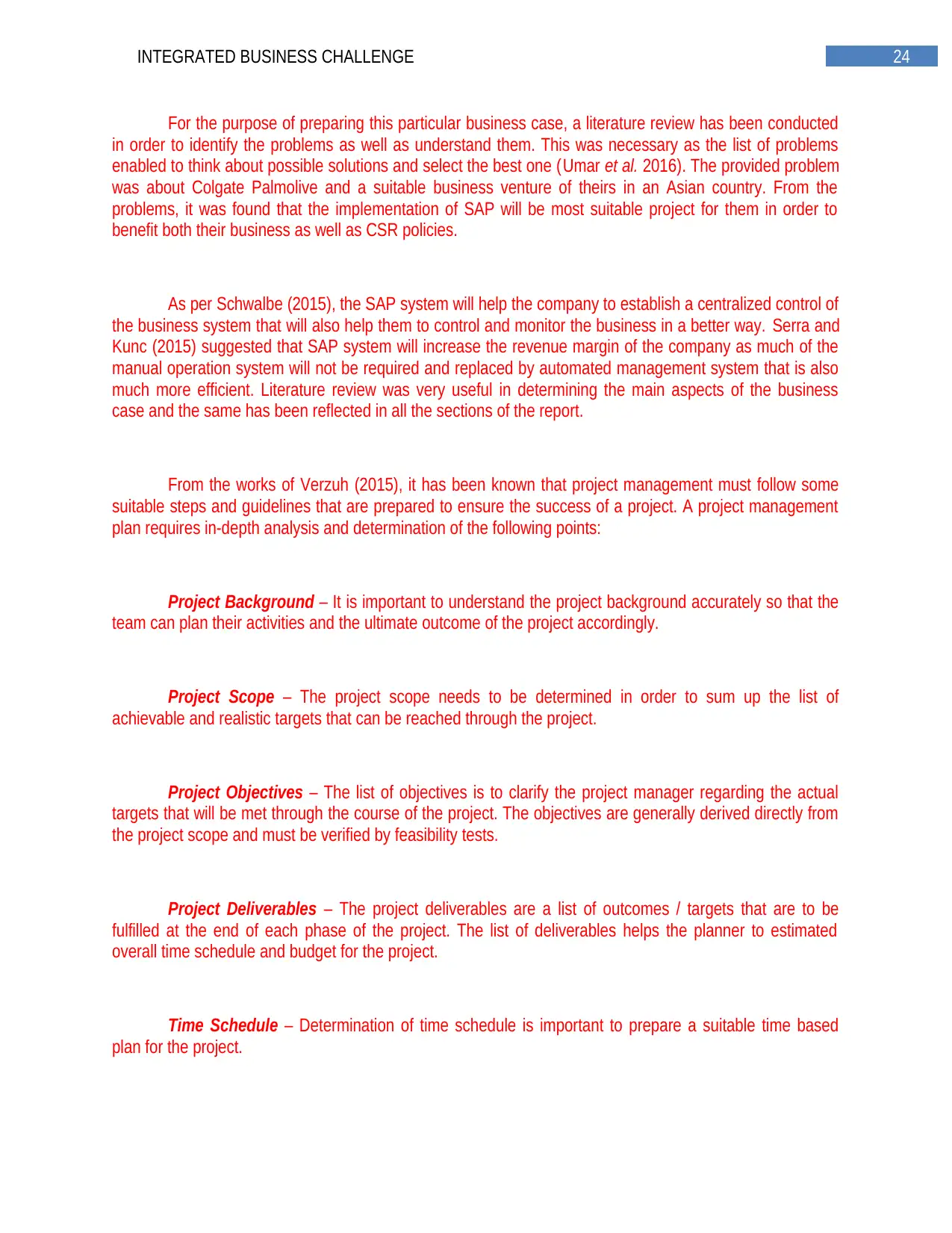
24INTEGRATED BUSINESS CHALLENGE
For the purpose of preparing this particular business case, a literature review has been conducted
in order to identify the problems as well as understand them. This was necessary as the list of problems
enabled to think about possible solutions and select the best one (Umar et al. 2016). The provided problem
was about Colgate Palmolive and a suitable business venture of theirs in an Asian country. From the
problems, it was found that the implementation of SAP will be most suitable project for them in order to
benefit both their business as well as CSR policies.
As per Schwalbe (2015), the SAP system will help the company to establish a centralized control of
the business system that will also help them to control and monitor the business in a better way. Serra and
Kunc (2015) suggested that SAP system will increase the revenue margin of the company as much of the
manual operation system will not be required and replaced by automated management system that is also
much more efficient. Literature review was very useful in determining the main aspects of the business
case and the same has been reflected in all the sections of the report.
From the works of Verzuh (2015), it has been known that project management must follow some
suitable steps and guidelines that are prepared to ensure the success of a project. A project management
plan requires in-depth analysis and determination of the following points:
Project Background – It is important to understand the project background accurately so that the
team can plan their activities and the ultimate outcome of the project accordingly.
Project Scope – The project scope needs to be determined in order to sum up the list of
achievable and realistic targets that can be reached through the project.
Project Objectives – The list of objectives is to clarify the project manager regarding the actual
targets that will be met through the course of the project. The objectives are generally derived directly from
the project scope and must be verified by feasibility tests.
Project Deliverables – The project deliverables are a list of outcomes / targets that are to be
fulfilled at the end of each phase of the project. The list of deliverables helps the planner to estimated
overall time schedule and budget for the project.
Time Schedule – Determination of time schedule is important to prepare a suitable time based
plan for the project.
For the purpose of preparing this particular business case, a literature review has been conducted
in order to identify the problems as well as understand them. This was necessary as the list of problems
enabled to think about possible solutions and select the best one (Umar et al. 2016). The provided problem
was about Colgate Palmolive and a suitable business venture of theirs in an Asian country. From the
problems, it was found that the implementation of SAP will be most suitable project for them in order to
benefit both their business as well as CSR policies.
As per Schwalbe (2015), the SAP system will help the company to establish a centralized control of
the business system that will also help them to control and monitor the business in a better way. Serra and
Kunc (2015) suggested that SAP system will increase the revenue margin of the company as much of the
manual operation system will not be required and replaced by automated management system that is also
much more efficient. Literature review was very useful in determining the main aspects of the business
case and the same has been reflected in all the sections of the report.
From the works of Verzuh (2015), it has been known that project management must follow some
suitable steps and guidelines that are prepared to ensure the success of a project. A project management
plan requires in-depth analysis and determination of the following points:
Project Background – It is important to understand the project background accurately so that the
team can plan their activities and the ultimate outcome of the project accordingly.
Project Scope – The project scope needs to be determined in order to sum up the list of
achievable and realistic targets that can be reached through the project.
Project Objectives – The list of objectives is to clarify the project manager regarding the actual
targets that will be met through the course of the project. The objectives are generally derived directly from
the project scope and must be verified by feasibility tests.
Project Deliverables – The project deliverables are a list of outcomes / targets that are to be
fulfilled at the end of each phase of the project. The list of deliverables helps the planner to estimated
overall time schedule and budget for the project.
Time Schedule – Determination of time schedule is important to prepare a suitable time based
plan for the project.
Paraphrase This Document
Need a fresh take? Get an instant paraphrase of this document with our AI Paraphraser
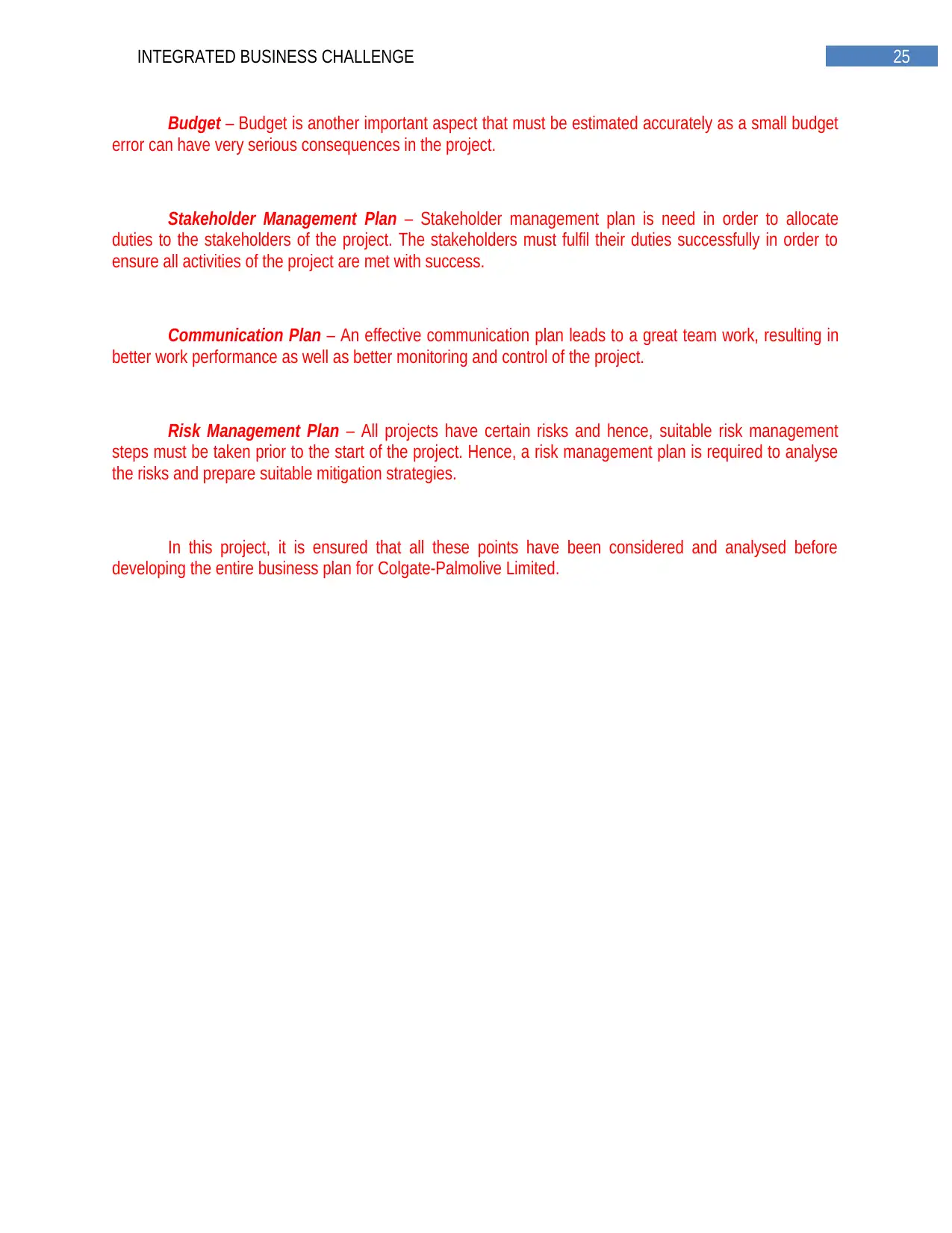
25INTEGRATED BUSINESS CHALLENGE
Budget – Budget is another important aspect that must be estimated accurately as a small budget
error can have very serious consequences in the project.
Stakeholder Management Plan – Stakeholder management plan is need in order to allocate
duties to the stakeholders of the project. The stakeholders must fulfil their duties successfully in order to
ensure all activities of the project are met with success.
Communication Plan – An effective communication plan leads to a great team work, resulting in
better work performance as well as better monitoring and control of the project.
Risk Management Plan – All projects have certain risks and hence, suitable risk management
steps must be taken prior to the start of the project. Hence, a risk management plan is required to analyse
the risks and prepare suitable mitigation strategies.
In this project, it is ensured that all these points have been considered and analysed before
developing the entire business plan for Colgate-Palmolive Limited.
Budget – Budget is another important aspect that must be estimated accurately as a small budget
error can have very serious consequences in the project.
Stakeholder Management Plan – Stakeholder management plan is need in order to allocate
duties to the stakeholders of the project. The stakeholders must fulfil their duties successfully in order to
ensure all activities of the project are met with success.
Communication Plan – An effective communication plan leads to a great team work, resulting in
better work performance as well as better monitoring and control of the project.
Risk Management Plan – All projects have certain risks and hence, suitable risk management
steps must be taken prior to the start of the project. Hence, a risk management plan is required to analyse
the risks and prepare suitable mitigation strategies.
In this project, it is ensured that all these points have been considered and analysed before
developing the entire business plan for Colgate-Palmolive Limited.
1 out of 26
Related Documents
Your All-in-One AI-Powered Toolkit for Academic Success.
+13062052269
info@desklib.com
Available 24*7 on WhatsApp / Email
![[object Object]](/_next/static/media/star-bottom.7253800d.svg)
Unlock your academic potential
© 2024 | Zucol Services PVT LTD | All rights reserved.





